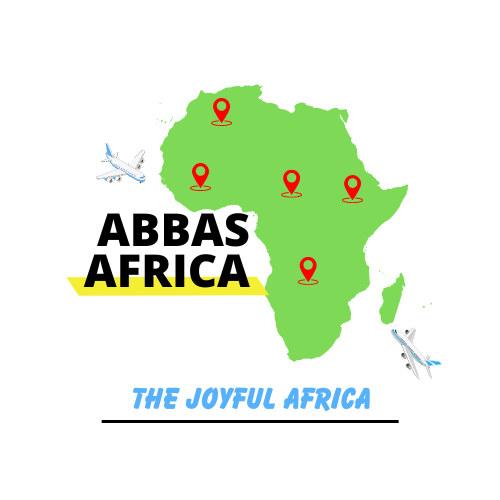
Abbas Africa
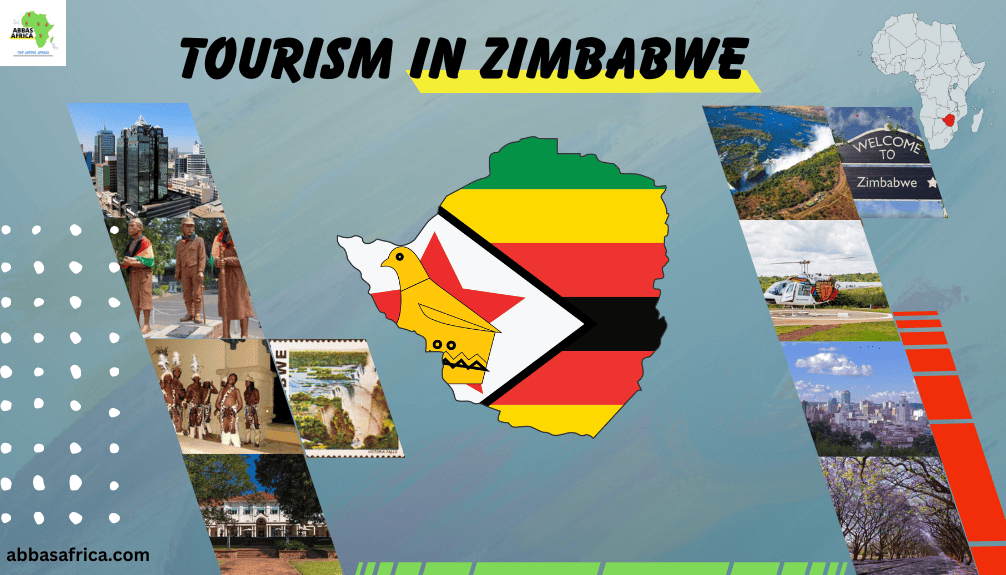

Tourism in Zimbabwe: Overview
As I stand before the majestic Victoria Falls, I am reminded of the sheer power and beauty that Zimbabwe has to offer. The tourism industry in this country is like a hidden gem waiting to be discovered, with its untapped potential and unique experiences.
But what exactly is the current state of tourism in Zimbabwe? How many visitors does it receive annually and how much revenue does it generate? Join me as we unravel the secrets of this prime tourism destination, explore its key sites and attractions, and uncover the role of technology in shaping Zimbabwean tourism.
Get ready to immerse yourself in the vibrant music, art, and culinary scene that enhances the overall tourism experience. Together, let’s journey through the history, prospects, and trends of tourism in Zimbabwe.
Key Takeaways
- Zimbabwe’s tourism industry has experienced significant growth in revenue, visitor numbers, and popularity, making it one of the most sought-after destinations in Africa.
- The number of visitors to Zimbabwe annually is an important indicator of the country’s appeal and the impact of tourism on its economy. It also helps in effectively planning and managing tourism resources.
- Zimbabwe attracts a diverse range of tourists, including wildlife enthusiasts, adventure seekers, and cultural explorers, due to its abundant national parks, thrilling activities, and rich cultural heritage.
- Tourism in Zimbabwe generates a substantial amount of revenue, contributing significantly to the country’s overall income. This revenue supports infrastructure development, job creation, and conservation efforts.
What Is the Current State of Tourism in Zimbabwe?
Zimbabwe’s tourism industry is currently facing both obstacles and opportunities for development. Despite the ongoing impact of COVID-19, the sector managed to generate approximately $397 million in 2021, showing growth compared to the previous year’s $360 million. However, according to the Zimbabwe Tourism Authority, the number of tourist arrivals dropped significantly from 639,369 in 2020 to 380,820 in 2021, largely due to the pandemic’s effects. The majority of visitors came from Africa and the Middle East, while other regions like the Americas, Oceania, Europe, and Asia experienced declines in tourist numbers. Although slightly lower than the Zimbabwe Tourism Authority’s report, WorldData recorded a total of 639,000 tourists in Zimbabwe in 2020, ranking the country 87th globally. The travel and tourism sector contributed around 4% to Zimbabwe’s GDP in 2021, according to Statista. Looking ahead, the Travel & Tourism market in Zimbabwe is projected to reach a revenue of $173.40 million by 2024, with an anticipated growth rate of 5.62% from 2024 to 2028. This indicates the resilience of Zimbabwe’s tourism industry and its potential for future expansion, it is currently ranked as the country’s third-largest sector, following mining and agriculture. It can make a substantial contribution to Zimbabwe’s economic revival.
How Many Visitors Does Zimbabwe Receive Annually?
As I explored the topic of tourism in Zimbabwe, I found some interesting numbers regarding the annual visitors. In 2022, tourist arrivals in Zimbabwe increased to 1,043,781 from 380,820 in 2021. The highest number of tourist arrivals was recorded in 2018 at 2,579,974, while the lowest was in 1980 at 237,668 according to Zimbabwe Tourism Authority. There was a significant drop in tourist arrivals from 2019 to 2020, with numbers falling from 2,294,259 to 639,356 due to the impact of COVID-19. Despite the challenges faced during the pandemic, Zimbabwe’s tourism industry is bouncing back, with an average of 1,642,477.60 tourist arrivals since 1980. This highlights the country’s potential for growth and reinforces its position as a desirable and exciting place for travelers to explore.
Who Are the Major Tourists in Zimbabwe?
The majority of tourists in Zimbabwe are Africans. In 2018, the majority of tourists visiting Zimbabwe were from African countries, with a total of 2,064,534 visitors. There were also 515,440 non-African tourists that year. In 2019, there were 1,872,565 African tourists and 421,603 tourists from overseas according to Zimbabwe Tourism Authority. By 2021, the number of African tourists decreased to 269,364 due to the COVID-19 pandemic, while the Americas became the second leading region of origin for international tourists, with approximately 21,000 visitors. In 2022, there was an increase in both African and overseas tourists, with 693,281 and 350,500 visitors respectively.
How Much Revenue Does Tourism Generate for Zimbabwe?
In 2021, the tourism sector in Zimbabwe experienced growth, generating $397 million in revenue compared to $360 million in the previous year. This growth is a positive sign despite challenges such as the impact of COVID-19, political instability, and economic uncertainty. According to Statista, travel and tourism contributed approximately 4% to Zimbabwe’s GDP in 2021.
Despite the obstacles faced, Zimbabwe’s tourism receipts have shown an upward trend, with a 24 percent increase to $272.26 million in the period leading up to September 2023. The Zimbabwe Tourism Authority projects that the tourism sector will continue to grow, reaching a revenue of $173.40 million by 2024. This growth is expected to continue at a rate of 5.62% from 2024 to 2028.
In terms of domestic and international spending, the total expenditure in the travel sector decreased from nearly one billion U.S. dollars in 2019 to 880 million U.S. dollars in 2021, as reported by Statista. Despite this decrease, the tourism sector still plays a significant role in Zimbabwe’s economy, accounting for 2.5 percent of total employment in the country in 2021, which amounts to 165,000 jobs. This indicates that tourism provides employment opportunities for locals and contributes to overall economic growth.
To further support the growth of the tourism economy, the Zimbabwean government has set a target to reach $5 billion by 2025. This demonstrates their commitment to developing and expanding the tourism sector in the country.
What Makes Zimbabwe a Prime Tourism Destination?
Zimbabwe is a prime tourism destination for several reasons.
Firstly, its rich cultural heritage is a major draw for tourists. From ancient ruins like Great Zimbabwe to vibrant festivals and traditional crafts, there’s so much to explore and learn about the country’s history and traditions.
Secondly, Zimbabwe boasts breathtaking natural wonders such as Victoria Falls, Hwange National Park, and the Great Zimbabwe National Monument, offering endless opportunities for wildlife encounters and awe-inspiring landscapes.
How Does Zimbabwe’s Rich Cultural Heritage Contribute to Its Appeal as a Tourist Destination?
As a prime tourism destination, Zimbabwe offers a rich cultural heritage that captivates visitors from around the world. From the vibrant and lively traditional music and dance performances to the fascinating historical sites that tell the story of the country’s past, tourists can encounter unique cultural experiences at every turn.
Immerse yourself in the local customs and traditions, sample the delicious local cuisine, and interact with the friendly and welcoming locals to truly appreciate the beauty and diversity of Zimbabwe’s cultural heritage.
What Are Some Unique Cultural Experiences That Tourists Can Encounter in Zimbabwe?
Zimbabwe offers a range of unique cultural experiences for tourists, including: Traditional village tours: Visitors can experience the traditional way of life in Zimbabwe by taking a village tour in Victoria Falls.
Cultural festivals: Zimbabwe hosts vibrant cultural festivals such as the Harare International Festival of the Arts, which provide opportunities for visitors to immerse themselves in traditional music, dance, and other art forms.
Heritage sites: Zimbabwe showcases its rich cultural heritage through UNESCO World Heritage Sites such as the Great Khami Ruins and Matobo Hills.
Traditional ceremonies: Visitors can witness traditional ceremonies and fascinating religious idols and sculptures, crafts work, folklore, and modern theater.
Wildlife viewing: Zimbabwe offers opportunities for wildlife viewing, including the Big Five, and eco-tourism experiences.
Authentic experiences: Zimbabwe emphasizes the authenticity of traditions and local communities, and promotes community-based tourism initiatives that allow visitors to engage with the local culture. These unique cultural experiences form the basis on which tourists can position Zimbabwe as a natural beauty, adventure, and sustainable tourism destination.
What Are the Must-See Natural Wonders in Zimbabwe?
When it comes to natural wonders, Zimbabwe is a treasure trove waiting to be explored. From majestic waterfalls to vast national parks, this country has it all.
Here are four must-see natural wonders that make Zimbabwe a prime tourism destination: The iconic Victoria Falls, one of the world’s largest waterfalls, is known as the ‘Smoke that Thunders.’
Hwange National Park is home to a diverse range of wildlife including elephants, lions, and giraffes.
Mana Pools National Park, a UNESCO World Heritage Site, offers breathtaking views of the Zambezi River and abundant wildlife.
Lake Kariba, the world’s largest man-made lake, is perfect for fishing, boating, and wildlife spotting.
How Does Zimbabwe’s Diverse Landscapes and Natural Wonders Attract Tourists?
Zimbabwe’s diverse landscapes and natural wonders captivate tourists, making it a prime destination for those seeking awe-inspiring beauty and adventure.
The country boasts magnificent national parks, such as Hwange and Mana Pools, where visitors can witness an abundance of wildlife in their natural habitats.
The iconic Victoria Falls, one of the world’s largest waterfalls, is a must-see attraction that leaves visitors spellbound.
The stunning landscapes, including the breathtaking Matobo Hills and the picturesque Eastern Highlands, offer endless opportunities for exploration and connection with nature.
Zimbabwe truly offers a captivating and unforgettable experience for every nature lover.
What Are the Key Sites and Destinations/Attractions in Zimbabwe?
When it comes to key sites and attractions in Zimbabwe, there’s no shortage of breathtaking options.
From the UNESCO World Heritage Sites like the majestic Victoria Falls and the ancient ruins of Great Zimbabwe to the vast national parks teeming with wildlife such as Hwange and Mana Pools, there’s something for everyone.
And let’s not forget the stunning beaches along Lake Kariba, perfect for unwinding and enjoying the serene beauty of Zimbabwe.
Lastly, for those interested in history and culture, the museums scattered throughout the country provide an enriching experience that showcases Zimbabwe’s rich heritage.
UNESCO World Heritage Sites in Zimbabwe
One of the most captivating aspects of Zimbabwe is its collection of UNESCO World Heritage Sites, which offer a glimpse into the country’s rich history and breathtaking natural beauty. These sites are a testament to Zimbabwe’s cultural and natural significance on a global scale.
Here are some of the key UNESCO World Heritage Sites in Zimbabwe:
- Great Zimbabwe : This ancient city is an architectural marvel, showcasing the impressive stone structures of the Shona civilization.
- Mana Pools National Park : Located along the Zambezi River, this park is a haven for wildlife, including elephants, lions, and hippos.
- Matobo Hills : Known for its stunning granite rock formations, this area isn’t only a place of natural beauty but also holds great spiritual and cultural significance for the local people.
- Victoria Falls : One of the Seven Natural Wonders of the World, this majestic waterfall is a sight to behold, attracting visitors from all over the globe.
Visiting these UNESCO World Heritage Sites allows you to immerse yourself in Zimbabwe’s rich heritage and experience its awe-inspiring natural wonders.
National Parks in Zimbabwe
With its diverse and stunning landscapes, Zimbabwe boasts an array of national parks that offer unparalleled opportunities for wildlife encounters and outdoor adventures. Whether you’re a nature enthusiast or simply looking to immerse yourself in the beauty of the African wilderness, these national parks are a must-visit destination.
Here are four key sites and attractions that should be on your itinerary:
- Hwange National Park : Known for its vast elephant population, Hwange National Park is the largest game reserve in Zimbabwe. Explore its vast plains and witness a diverse range of wildlife, including lions, giraffes, and antelopes.
- Mana Pools National Park : Situated on the banks of the mighty Zambezi River, Mana Pools National Park offers a unique safari experience. Witness elephants bathing in the river, spot hippos and crocodiles, and embark on thrilling canoe safaris.
- Matobo National Park : Famous for its ancient rock formations and rich cultural history, Matobo National Park is a UNESCO World Heritage Site. Discover ancient rock art, go rhino tracking, and enjoy breathtaking views from the top of the granite hills.
- Gonarezhou National Park : Located in the southeastern part of the country, Gonarezhou National Park is a hidden gem. Explore its rugged landscapes, spot the elusive African wild dogs, and take a dip in the stunning Chilojo Cliffs.
In Zimbabwe’s national parks, you’ll find a sense of belonging as you connect with nature and witness the incredible wildlife that calls these parks home.
Beaches in Zimbabwe
As I continue exploring the diverse and captivating landscapes of Zimbabwe, I’m drawn to the allure of its pristine beaches, which offer a refreshing contrast to the country’s renowned national parks. Here are some of the key sites and attractions that make Zimbabwe’s beaches truly special:
- Victoria Falls : Not only famous for its magnificent waterfall, Victoria Falls also boasts a stunning riverfront with sandy beaches where visitors can relax and take in the breathtaking views.
- Lake Kariba : This massive lake, formed by the Kariba Dam, stretches along Zimbabwe’s northern border, offering picturesque beaches and ample opportunities for fishing, boating, and wildlife viewing.
- Eastern Highlands : Nestled in Zimbabwe’s eastern region, the Eastern Highlands are adorned with crystal-clear rivers and beautiful waterfalls, creating idyllic spots for picnics and leisurely walks along the riverbanks.
- Mozambique Border : Zimbabwe shares a border with Mozambique, where pristine beaches await. From the coastal town of Beira to the tropical paradise of Bazaruto Island, these beaches offer a slice of paradise for sun-seekers and water sports enthusiasts alike.
With these stunning beach destinations, Zimbabwe truly offers something for everyone, inviting you to experience the beauty and serenity of its coastal treasures.
Museums in Zimbabwe
Zimbabwe’s rich history and cultural heritage come to life through its impressive array of museums, showcasing the country’s key sites, destinations, and attractions. These museums offer a glimpse into the fascinating past of Zimbabwe, captivating visitors with their informative exhibits and interactive displays.
Here are some must-visit museums in Zimbabwe:
- National Museum of Zimbabwe : Explore the country’s history, archaeology, and art through its extensive collection of artifacts and artworks.
- Great Zimbabwe Museum : Delve into the ancient civilization of Great Zimbabwe, with its iconic stone ruins and rich cultural significance.
- Bulawayo Railway Museum : Step back in time and discover the history of railways in Zimbabwe, with vintage locomotives and carriages on display.
- Zimbabwe Museum of Human Sciences : Learn about the diverse culture and traditions of Zimbabwe’s people, from ancient times to the present day.
These museums offer a unique and immersive experience, allowing visitors to connect with the heritage and stories of Zimbabwe, fostering a sense of belonging and appreciation for the country’s rich past.
What Are the Key Trends that Are Propelling the Growth of Tourism in Zimbabwe?
- Safari adventures that offer up-close encounters with the country’s diverse wildlife.
- Cultural tourism experiences that allow visitors to immerse themselves in Zimbabwe’s rich heritage and traditions.
- The development of luxury resorts and eco-lodges that provide a unique and sustainable way to experience the country.
- The promotion of adventure tourism activities, such as white-water rafting, bungee jumping, and hiking in the stunning landscapes of Zimbabwe.
These key trends are driving the growth of tourism in Zimbabwe by catering to the desires of travelers who seek authentic experiences, connection with nature, and a sense of adventure. With its abundant wildlife, vibrant culture, and breathtaking scenery, Zimbabwe offers a wealth of opportunities for tourists to explore, learn, and create lasting memories.
Whether it’s embarking on a thrilling safari, engaging with local communities, or indulging in luxury accommodations, Zimbabwe has something for everyone. So, pack your bags and get ready to discover the wonders of this beautiful country.
How Does Zimbabwe Contribute to Tourism in Africa?
Zimbabwe contributes to tourism in Africa through its diverse attractions such as Victoria Falls, one of the largest waterfalls in the world, and its abundant wildlife in national parks like Hwange and Mana Pools. The country offers unique experiences like safari tours, cultural encounters, and adventure activities like white-water rafting. Zimbabwe’s welcoming people, rich history, and vibrant culture also play a significant role in attracting visitors to explore this beautiful African destination.
What Is the Overall Importance of Tourism for Zimbabwe?
The growth of tourism in Zimbabwe not only brings about exciting safari adventures and cultural experiences but also plays a vital role in the country’s overall development. Here are some key reasons why tourism is important for Zimbabwe:
- Economic Impact : Tourism is Zimbabwe’s third-largest sector after mining and agriculture, contributing significantly to the country’s GDP (4% in 2021), it contributes to the country’s economy by generating revenue, creating job opportunities, and boosting foreign exchange earnings.
- Infrastructure Development : The tourism industry drives the development of infrastructure such as transportation networks, accommodation facilities, and tourist attractions, which benefits both tourists and locals.
- Community Development and Cultural Preservation : Tourism provides opportunities for local communities to engage in sustainable livelihoods, preserves cultural heritage, and encourages the conservation of natural resources.
- Global Image and Brand : A thriving tourism sector enhances Zimbabwe’s international reputation, attracting more tourists and investment, and promoting a positive image of the country.
What Are the Key Potential Benefits of Tourism for Zimbabwe?
Tourism in Zimbabwe holds immense potential to unlock a world of benefits and opportunities for the country and its people. Here are the key potential benefits that tourism can bring to Zimbabwe:
- Economic growth : Tourism has the power to stimulate the economy by creating jobs, generating revenue, and attracting foreign investment.
- Cultural preservation : Tourism can help preserve Zimbabwe’s rich cultural heritage by encouraging the protection and promotion of traditional arts, crafts, and customs.
- Infrastructure development : The development of tourism infrastructure, such as hotels, roads, and airports, can benefit not only tourists but also the local community.
- Global recognition : By attracting tourists from around the world, Zimbabwe can enhance its global image and reputation, showcasing its natural beauty, wildlife, and unique experiences.
With the right planning and investment, tourism can play a vital role in the sustainable development of Zimbabwe, benefiting both the country and its people.
What Are the Key Challenges Facing Zimbabwe’s Tourism?
Facing numerous challenges, Zimbabwe’s tourism industry must navigate a complex landscape to realize its full potential. As a thriving industry that contributes significantly to the country’s economy, it faces several key challenges:
- Political instability and security concerns that deter tourists from visiting.
- Limited infrastructure, including inadequate road networks and unreliable power supply, hindering accessibility and comfort for tourists.
- Poor marketing and branding efforts that fail to effectively promote Zimbabwe as a desirable tourism destination.
- Conservation issues, such as poaching and unsustainable practices, threaten the country’s wildlife and natural attractions.
Despite these challenges, Zimbabwe’s tourism industry has immense potential. By addressing these issues and implementing strategic measures, the country can attract more tourists, boost its economy, and showcase its rich cultural heritage and breathtaking landscapes to the world.
What Are the Untapped Potentials in Zimbabwe’s Tourism Sector?
As Zimbabwe’s tourism industry works towards overcoming its key challenges, there lies a wealth of untapped potential waiting to be explored and capitalized on. Here are some of the untapped potentials in Zimbabwe’s tourism sector:
- Rich cultural heritage : Zimbabwe is home to diverse ethnic groups, each with its unique traditions, music, dance, and cuisine. Exploring and promoting this cultural heritage can attract tourists looking for an authentic experience.
- Wildlife conservation : Zimbabwe boasts an abundance of wildlife, including the Big Five. By investing in sustainable wildlife conservation efforts and promoting responsible tourism, the country can attract nature enthusiasts and eco-conscious travelers.
- Adventure tourism : With its stunning landscapes, Zimbabwe offers a wide range of adventure activities such as hiking, white-water rafting, and zip-lining. Developing and promoting adventure tourism can attract thrill-seekers and adrenaline junkies.
- Historical sites : Zimbabwe has a rich history, including ancient ruins such as the Great Zimbabwe and Khami. Preserving and promoting these historical sites can attract history buffs and archaeology enthusiasts.
How Does Tourism Contribute to the Economic Growth and Development of Zimbabwe?
As someone who’s witnessed the tourism development in Zimbabwe firsthand, I can confidently say that it plays a crucial role in the economic growth and development of the country.
Tourism contributes significantly to the economic growth and development of Zimbabwe in several ways:
Contribution to GDP: Zimbabwe’s tourism sector contributed 4% of the country’s GDP in 2021, generating $397 million, making it one of the fastest-growing industries.
Employment Opportunities: The tourism industry’s expansion has generated employment in the hospitality, transportation, and retail sectors. In 2021, 165,000 jobs were created, accounting for 2.5% of the country’s total employment.
Infrastructure Development: The development of tourism infrastructure, including hotels, lodges, and other tourism facilities, has contributed to the overall economic growth of the country.
Foreign Exchange Earnings: Tourism is a significant source of foreign exchange earnings for Zimbabwe, helping to relieve the foreign exchange constraint and promote economic growth.
Community Development: Tourism has the potential to uplift local communities by providing employment opportunities, promoting local businesses, and fostering cultural exchange.
Cultural Preservation: Tourism helps preserve and promote Zimbabwe’s rich cultural heritage, including traditional customs, music, dance, and unique art forms.
Global Image and Brand: Zimbabwe’s diverse natural attractions, such as national parks, Victoria Falls, and the Great Zimbabwe National Monument, have the potential to attract tourists and enhance the country’s global image and brand.
These factors collectively demonstrate the significant contribution of tourism to the economic growth and development of Zimbabwe, making it a vital sector for the country’s future prosperity.
How Is the Tourism Development Going In Zimbabwe?
Tourism in Zimbabwe plays a pivotal role in driving economic growth and development, as it contributes significantly to the country’s revenue and employment opportunities (165 thousand jobs in 2021).
In recent years, Zimbabwe has experienced a positive trend in tourism development. The government has implemented various strategies to attract more tourists, such as improving infrastructure, promoting cultural heritage, and ensuring safety and security for visitors. As a result, the number of international tourists has been steadily increasing, with 1,043,781 visitors in 2022 from 380,820 in 2021.
The Zimbabwean government has taken steps to promote investment in the tourism industry through initiatives such as tax incentives and other supportive measures. Furthermore, the International Finance Corporation (IFC) is actively involved in assisting Zimbabwe in enhancing the economic impact of tourism, attracting private sector investment in targeted areas, and fostering a more conducive business environment. The tourism industry in Zimbabwe is gradually recovering and growing, offering unique experiences and opportunities for both visitors and locals alike.
What Are the Cultural and Environmental Impacts of Tourism in Zimbabwe?
With each passing year, Zimbabwe’s vibrant culture and breathtaking environment are both shaped and influenced by the steady influx of tourists.
The cultural impact of tourism in Zimbabwe is evident in the interactions between locals and visitors. As tourists immerse themselves in the local customs and traditions, they gain a deeper understanding and appreciation for the rich cultural heritage of Zimbabwe. This exchange of ideas and experiences fosters a sense of belonging and unity among different communities.
Furthermore, the environmental impact of tourism in Zimbabwe is significant. The country’s stunning natural landscapes, such as Victoria Falls and Hwange National Park, attract tourists from around the world. However, it’s crucial to ensure sustainable practices to protect these fragile ecosystems and preserve them for future generations. Efforts are being made to promote responsible tourism and conservation initiatives to minimize any negative impacts on Zimbabwe’s environment.
What Are the Main Types of Tourism in Zimbabwe?
Several types of tourism in Zimbabwe await travelers, including: Wildlife Tourism: Zimbabwe is home to a diverse range of wildlife, including the Big Five, and offers opportunities for wildlife viewing and eco-tourism experiences.
Cultural Tourism: Zimbabwe’s rich cultural heritage, including traditional customs, music, dance, and unique art forms, attracts visitors interested in cultural experiences.
Business Tourism: Zimbabwe has the potential to attract business travelers, with opportunities to develop conference and convention centers, resorts, and shopping malls.
When it comes to tourism in Zimbabwe, one of the main types that stands out is safari tours. These thrilling adventures allow visitors to explore the country’s diverse and stunning wildlife in their natural habitats.
From the majestic elephants roaming freely in Hwange National Park to the breathtaking Victoria Falls, Zimbabwe offers an array of safari experiences that cater to all interests and budgets.
How Popular Are Safari Tours in Zimbabwe?
When it comes to safari tours in Zimbabwe, they aren’t just popular, they’re a must-do experience for wildlife enthusiasts like myself.
The country is known for its abundant and diverse wildlife, making it a prime destination for African wildlife tourism.
From spotting majestic elephants and lions to witnessing the breathtaking beauty of Victoria Falls, Zimbabwe offers a range of safari experiences that cater to different interests and budgets.
Whether you choose to explore the famous Hwange National Park or embark on a canoe safari along the Zambezi River, the thrill of encountering these magnificent creatures in their natural habitat is truly unparalleled.
Is African Wildlife Tourism in Zimbabwe Worth the Experience?
Exploring the diverse African wildlife through tourism in Zimbabwe is a captivating and enriching experience that’s well worth the adventure. The country’s breathtaking landscapes and abundance of wildlife make it a prime destination for safari tours.
Witnessing majestic elephants roaming freely, spotting elusive leopards in their natural habitat, and encountering rare bird species are just a few of the incredible encounters you can have.
Zimbabwe’s commitment to conservation ensures that you not only have a thrilling experience but also contribute to the preservation of these magnificent creatures.
What Are the Top Tourist Destinations in Zimbabwe?
Zimbabwe offers several tourist destinations, including national parks, natural attractions, cultural sites, and historical landmarks. Here are some of the top tourist destinations in Zimbabwe: Victoria Falls: One of the most iconic tourist sites in Zimbabwe, Victoria Falls is a UNESCO World Heritage Site and one of the largest waterfalls in the world.
Harare: The capital city of Zimbabwe, Harare offers a range of attractions, including historical sites, museums, and cultural experiences
Hwange National Park: Zimbabwe’s largest national park, Hwange is home to a diverse range of wildlife, including elephants, lions, and giraffes.
Great Zimbabwe National Monument: This ancient city and UNESCO World Heritage Site showcases the rich history and culture of the region.
Lake Kariba: One of the largest man-made lakes in the world, Lake Kariba offers opportunities for fishing, boating, and wildlife viewing.
These are just a few of the many tourist destinations that Zimbabwe has to offer. Visitors can also experience cultural tourism, adventure tourism, and ecotourism in Zimbabwe.
How Safe Is Traveling for Tourists in Zimbabwe?
As a tourist in Zimbabwe, I feel safe and secure exploring its top destinations. The country has made significant improvements in terms of safety and security for travelers. The government has implemented measures to ensure the well-being of tourists, such as increased police presence in popular tourist areas and enhanced security at airports.
Zimbabwe is known for its warm and welcoming people, who prioritize the safety and comfort of visitors. Popular tourist destinations like Victoria Falls, Hwange National Park, and Great Zimbabwe are well-maintained and have dedicated security personnel to ensure a peaceful experience.
It’s always advisable to take common precautions, such as avoiding isolated areas at night and keeping an eye on personal belongings.
What Are the Best Times to Visit Zimbabwean Destinations?
One of the top tourist destinations in Zimbabwe is the magnificent Victoria Falls. Known as the ‘Smoke that Thunders,’ this iconic waterfall is a sight to behold.
But what are the best times to visit Zimbabwe’s other incredible destinations? Let me guide you through the seasons.
If you’re a wildlife enthusiast, the dry season from May to October is perfect for game viewing in Hwange National Park. The animals gather around waterholes, making it easier to spot them. For bird lovers, the wet season from November to March is ideal, as migratory birds flock to the area.
For a cultural experience, visit Zimbabwe during its vibrant festivals like the Harare International Festival of the Arts in May or the Zimbabwe International Film Festival in October.
No matter when you choose to visit, Zimbabwe offers something for everyone. So pack your bags and get ready to embark on an unforgettable adventure in this beautiful country.
Are There Specialized Travel Agencies for Zimbabwe Tourism?
Yes, there are specialized travel agencies for Zimbabwe tourism. Some of the travel agencies and tour operators in Zimbabwe include: Travelo Zimbabwe: A reputed tour operator in Zimbabwe that arranges custom tour packages with an expert local tour guide to explore Zimbabwe tourism.
Intrepid Travel: A tour operator that offers a range of tours and experiences in Zimbabwe, including wildlife safaris, cultural tours, and adventure activities.
DK Tours & Safaris: A tour operator that specializes in wildlife safaris and cultural tours in Zimbabwe.
Contiki: A tour operator that offers a range of tours and experiences for young travelers in Zimbabwe, including adventure activities and cultural tours.
Off2Africa Travel: A Zimbabwe-based tour operator that offers African safari tours and has been in business for over 15 years.
These travel agencies and tour operators offer a range of services and experiences for tourists visiting Zimbabwe, including wildlife safaris, cultural tours, adventure activities, and more.
How Can Tourists Find Reputable Travel Agencies in Zimbabwe?
When searching for reputable travel agencies in Zimbabwe, tourists can easily find specialized agencies that cater specifically to Zimbabwe tourism. These agencies are well-equipped with the knowledge and expertise to provide tourists with the best possible experience in the country.
One way tourists can find reputable travel agencies is by conducting thorough research online. There are numerous websites and travel forums that provide reviews and recommendations for travel agencies in Zimbabwe. Additionally, tourists can seek advice from fellow travelers who’ve visited Zimbabwe before. They can share their experiences and suggest reliable travel agencies that they’ve personally used.
It’s also advisable to check if the travel agency is a member of recognized tourism associations or has any certifications that vouch for their credibility.
Are There Any Travel Insurance Companies in Zimbabwe?
Yes, there are travel insurance options available in Zimbabwe. Some of the companies that offer travel insurance for Zimbabwe include:
Andean Peaks Travel Insurance: Offers travel insurance for Zimbabwe, covering trip cancellation, trip interruption, lost baggage, and more.
Allianz Global Assistance: Provides comprehensive plans for Zimbabwe travelers, covering medical expenses, trip cancellation, baggage loss, and emergency evacuation.
Old Mutual Zimbabwe: Offers travel insurance covering unforeseen trip cancellation, loss, theft, and damage to baggage when traveling, as well as international medical and hospitalization expenses.
TravelSafe Insurance: It has a strong reputation for excellent customer service and quick claims processing.
CBZ Holdings: Offers travel insurance that covers medical expenses and other losses incurred while traveling internationally.
With these travel insurance companies in Zimbabwe, visitors can explore the country with confidence, knowing that they have the necessary coverage in case of any unexpected events.
What Visa and Travel Requirements Should Tourists Know About When Visiting Zimbabwe?
After ensuring that I had the necessary travel insurance coverage, I visited Zimbabwe and familiarized myself with the visa and travel requirements to have a hassle-free experience.
When traveling to Zimbabwe, it’s important to have a valid passport with at least six months of remaining validity. Most tourists are required to obtain a visa, which can be obtained upon arrival or in advance from the Zimbabwean embassy or consulate in their home country.
The visa fees vary depending on the traveler’s nationality and the duration of their stay. It’s also important to note that tourists must have a return or onward ticket and sufficient funds to cover their stay in Zimbabwe.
Additionally, it’s recommended to check the latest travel advisories and requirements before planning a trip to Zimbabwe to ensure a smooth and enjoyable visit.
How to Plan Your Trip to Zimbabwe?
Here are 5 basic steps to plan your trip to Zimbabwe: Research and choose the best time to visit Zimbabwe based on weather and seasonal attractions.
Determine your budget and decide on the duration of your trip.
Create an itinerary based on your interests, including must-visit destinations such as Victoria Falls, Hwange National Park, and Matobo National Park.
Book flights, accommodations, and any necessary transportation in advance to secure the best deals.
Familiarize yourself with the country’s visa requirements and ensure you have all necessary travel documents before departing.
What Are Some Things to Do in Zimbabwe?
When visiting Zimbabwe, you’ll be amazed by the diverse range of activities and experiences that await you. From exploring the magnificent Victoria Falls to embarking on thrilling wildlife safaris, this country offers something for everyone.
One must-see attraction is Hwange National Park, home to a vast array of wildlife, including elephants, lions, and giraffes.
For history enthusiasts, a visit to the Great Zimbabwe Ruins is a must. These ancient ruins are a UNESCO World Heritage Site and provide a fascinating glimpse into Zimbabwe’s rich history and culture.
If you’re seeking adventure, take a canoe trip down the Zambezi River or go hiking in the stunning Eastern Highlands.
Don’t forget to indulge in the delicious local cuisine and immerse yourself in the vibrant music and dance traditions of Zimbabwe.
With so much to see and do, a trip to Zimbabwe promises an unforgettable experience.
What Are Some Interesting Facts and Statistics About Tourism in Zimbabwe?
When it comes to tourism in Zimbabwe, there are some interesting facts and statistics that set it apart from other African countries. Here are some interesting facts and statistics about tourism in Zimbabwe: Tourism is Zimbabwe’s third-largest sector after mining and agriculture, contributing approximately 4% of GDP and 2.5% of total employment.
In 2020, Zimbabwe recorded a total of 639,369 tourists, ranking 87th in the world in absolute terms.
Zimbabwe has several national parks and natural attractions, such as Hwange, Mana Pools, and Gonarezhou National Parks, Victoria Falls, Lake Kariba, and the Great Zimbabwe National Monument.
The vast majority of tourists in Zimbabwe are Africans.
These facts and statistics illustrate the significance of tourism to Zimbabwe’s economy, its potential for growth, and the impact of external factors such as the COVID-19 pandemic on tourist arrivals and revenue.
How Does Zimbabwe’s Tourism Industry Compare to Other African Countries?
Zimbabwe’s tourism industry stands out among its African counterparts, boasting fascinating facts and statistics that showcase its unique appeal.
While many African countries rely heavily on wildlife and natural landscapes to attract tourists, Zimbabwe offers a diverse range of attractions that set it apart.
For starters, Zimbabwe is home to the majestic Victoria Falls, one of the Seven Natural Wonders of the World.
Additionally, the country boasts an impressive array of national parks, including Hwange National Park, which is famous for its large elephant populations.
Furthermore, Zimbabwe’s rich cultural heritage, with its ancient ruins such as Great Zimbabwe, adds to its allure.
In terms of visitor arrivals, Zimbabwe has seen a steady increase in recent years, with tourists from neighboring South Africa, as well as the United Kingdom, Germany, and the United States, making up a significant portion of the arrivals.
With its breathtaking natural beauty and vibrant cultural experiences, Zimbabwe’s tourism industry offers an enchanting and unforgettable experience for travelers seeking a sense of belonging in the heart of Africa.
What Is the Difference Between Tourism in Zimbabwe and Tourism in Gabon?
There is a notable contrast between tourism in Gabon and tourism in Zimbabwe. Zimbabwe boasts natural beauty, wildlife, and cultural heritage, offering activities like game drives and cultural tours. In comparison, Gabon is known for its rainforests, wildlife, and beaches, with unique experiences such as gorilla trekking and whale watching. Zimbabwe has a more developed tourism infrastructure and is more affordable, while Gabon is still emerging in the industry. Ultimately, the choice depends on preferences, budget, and travel goals.
What’s the Role of Technology in Shaping Zimbabwean Tourism?
In shaping Zimbabwean tourism, technology plays a pivotal role, revolutionizing the way visitors experience the country’s rich cultural heritage and breathtaking natural wonders.
With the widespread use of smartphones and internet connectivity, tourists can easily access information and plan their trips efficiently. Online platforms and mobile apps provide a virtual tour of Zimbabwe’s iconic landmarks, allowing visitors to explore the country’s beauty from the comfort of their own homes.
Furthermore, technology has enhanced the booking process, making it easier for tourists to find accommodation, book flights, and organize transportation.
Virtual reality and augmented reality technologies have also opened up new possibilities, allowing tourists to immerse themselves in virtual experiences that showcase Zimbabwe’s attractions uniquely and engagingly. From virtual safaris to interactive museum exhibits, technology offers a window into the wonders of Zimbabwe, creating a sense of belonging and inspiring visitors to explore this magnificent country in person.
How Does the Vibrant Zimbabwe’s Music, Art, and Culinary Scene Enhance the Overall Tourism Experience?
The vibrant music, art, and culinary scene in Zimbabwe add a dynamic and immersive element to the overall tourism experience, captivating visitors with its rich cultural expressions and tantalizing flavors.
From the rhythmic beats of traditional mbira music to the vibrant colors and intricate designs of Shona sculptures, Zimbabwe’s artistic offerings are a feast for the senses. The country’s music and art scene not only provide entertainment but also serve as a window into the history and traditions of the Zimbabwean people.
When it comes to cuisine, Zimbabwe’s diverse culinary scene offers a delightful array of flavors, from the spicy and savory dishes of the local cuisine to international delicacies.
Exploring the music, art, and culinary scene in Zimbabwe allows tourists to fully immerse themselves in the vibrant culture of the country, creating memories that will last a lifetime.
What Is the History of Tourism in Zimbabwe?
As I explore the vibrant music, art, and culinary scene in Zimbabwe, it’s fascinating to delve into the history of tourism in this captivating country.
Zimbabwe has a rich history of attracting visitors from all over the world. The roots of tourism in Zimbabwe can be traced back to the colonial era when the country was known as Rhodesia. During this time, the stunning landscapes, abundant wildlife, and the majestic Victoria Falls started to captivate the imaginations of travelers.
The tourism industry began to flourish in the 1980s after Zimbabwe gained independence. The government recognized the economic potential of tourism and invested in infrastructure and promotion.
Today, Zimbabwe continues to charm tourists with its diverse natural beauty, rich cultural heritage, and warm hospitality. The history of tourism in Zimbabwe is a testament to the country’s enduring appeal as a must-visit destination.
What Are the Future Prospects and Trends for Tourism in Zimbabwe?
With its untapped natural beauty and thriving cultural heritage, Zimbabwe is poised to become one of the hottest destinations for adventurous travelers in the coming years.
The prospects and trends for tourism in Zimbabwe are incredibly promising. The government has taken significant steps to improve infrastructure and promote sustainable tourism, attracting a wider range of visitors.
The country’s national parks, such as Hwange and Mana Pools, offer incredible opportunities for wildlife enthusiasts and nature lovers.
The majestic Victoria Falls continues to be a major drawcard, with activities like white-water rafting and bungee jumping attracting thrill-seekers.
Additionally, the rich cultural history of Zimbabwe, including the ancient ruins of Great Zimbabwe and the vibrant local arts scene, provides unique experiences for cultural enthusiasts.
As more people seek authentic and off-the-beaten-path destinations, Zimbabwe is poised to fulfill their desires and offer a sense of belonging to those who choose to explore its wonders.
In conclusion, Zimbabwe’s tourism industry is experiencing significant growth and has become a prime destination for travelers.
With its unique attractions, such as the majestic Victoria Falls and diverse wildlife, Zimbabwe offers a rich and unforgettable experience for visitors.
The country’s history, vibrant music and art scene, and culinary delights further enhance the overall tourism experience.
As technology continues to shape the industry, Zimbabwe’s tourism sector is poised for a promising future with increasing visitor numbers and revenue.

Zimbabwe Tourism: Your Comprehensive Zimbabwe Travel Guide
Landlocked and in the center of Southern Africa, Zimbabwe has been an important trade center as well as the most strategic spot for British Settlement since the 18th century. This comprehensive Zimbabwe travel guide highlights the best of Zimbabwe.

With the British politician and businessman conquering the territory and taking possession of the mines, the area was named Rhodesia by the Queen.
Initially founded as a British Colony called Southern Rhodesia, it gained independence in 1965 as Rhodesia. The following 15 years saw violent guerilla wars between the white minorities and black nationalists, which ended up in the foundation of the Republic of Zimbabwe in 1980.
Initially appointed as a prime minister, the longest-running president was Robert Mugabe from 1987 until his resignation in 2017. During his authoritarian rule, he was held accountable for the increased mortality rate as well as the declining life expectancy and economy.
In November 2017, his reign came to an end as he was put under house arrest after a coup d’etat. He was then replaced by the vice president Emmerson Mnangagwa. This created a tension between the supporters of Mugabe and those who opposed him.
Zimbabwe Travel Guide: Things to Do, Places to Stay, Culture, and Travel Tips
Capital: Harare Official languages: English, Shona, Ndebele, Southern Sotho, Tswana, Xhosa, Venda, Chewa, Tsonga, Tonga President: Emmerson Mnangagwa Currencies: United States Dollar, Indian rupee, Pound sterling, and more…
Plan a Trip to Zimbabwe
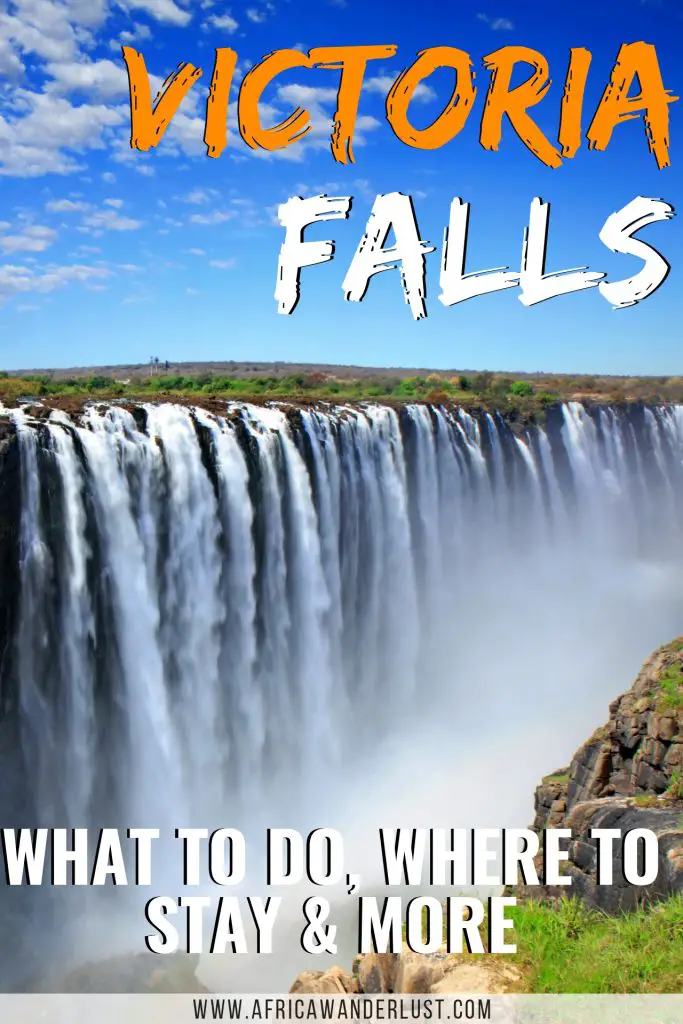
Points of Interest: Victoria Falls , Hwange National Park , Zimbabwe Ruins , and more… Average Flight Time: 24 h 30 min flight Fun Fact: Zimbabwe has not one but two largest water body in the world – Victoria Falls, the largest waterfall in the world, and Lake Kariba , the largest man-made lake in the world.
Why Visit Zimbabwe
Amongst all the political unrest, Zimbabwe’s touristic profile has been on a rapid decline. However, that is not to say that Zimbabwe has nothing to offer. On the contrary, the country has several tourist attractions and is one of the safest countries in Africa to visit .
The magnificent Victoria Falls on the Zambezi River at the border between Zambia and Zimbabwe is the sole reason for visiting as one of the most popular natural wonders of the world. Furthermore, national parks like Hwange National Park and Nyanga National Park offer spectacular wildlife.
The country is also home to some of the most striking examples of Victorian dry stone architecture that can be observed in ancient cities. This travel guide will provide detailed information about Zimbabwe’s hidden gems.
Best of Zimbabwe
Best places to stay in zimbabwe.
#1 Victoria Falls Hotels
This Edwardian style hotel gives you a stunning view of Batoka Gorge with magnificent Victoria Falls only a short walk. The Victoria Falls Hotel features three restaurants, an amazing swimming pool, fitness center, and more.
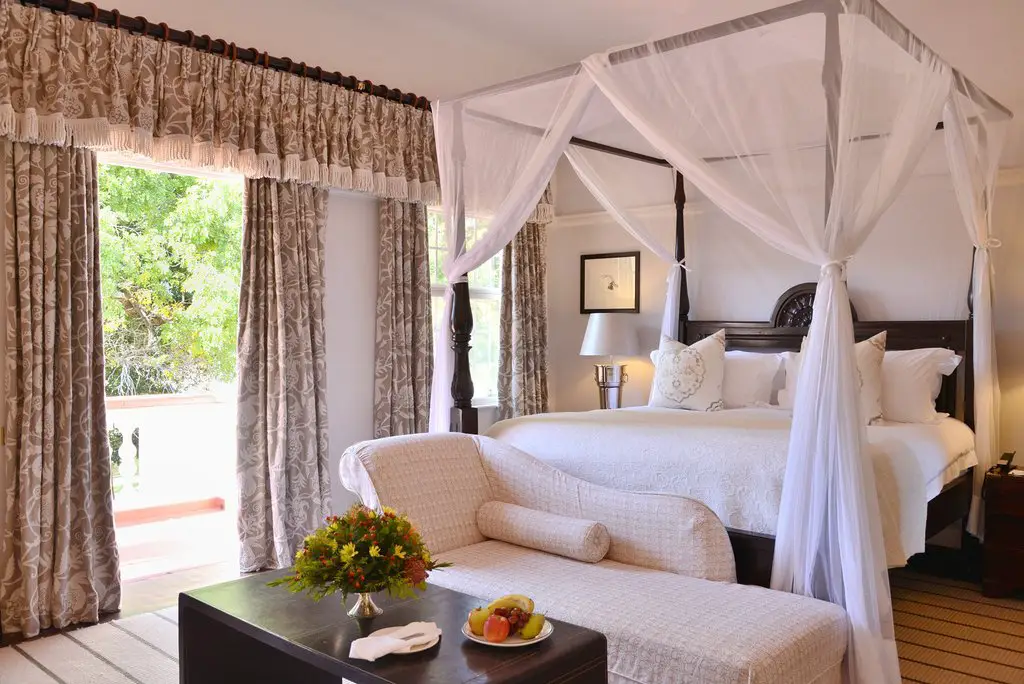
#2 Shearwater Explorers Village
Shearwater Explorers Village offers low-cost accommodation without compromising on style and comfort. And it’s no surprise that the Explorers Village is only 400 meters from the falls.
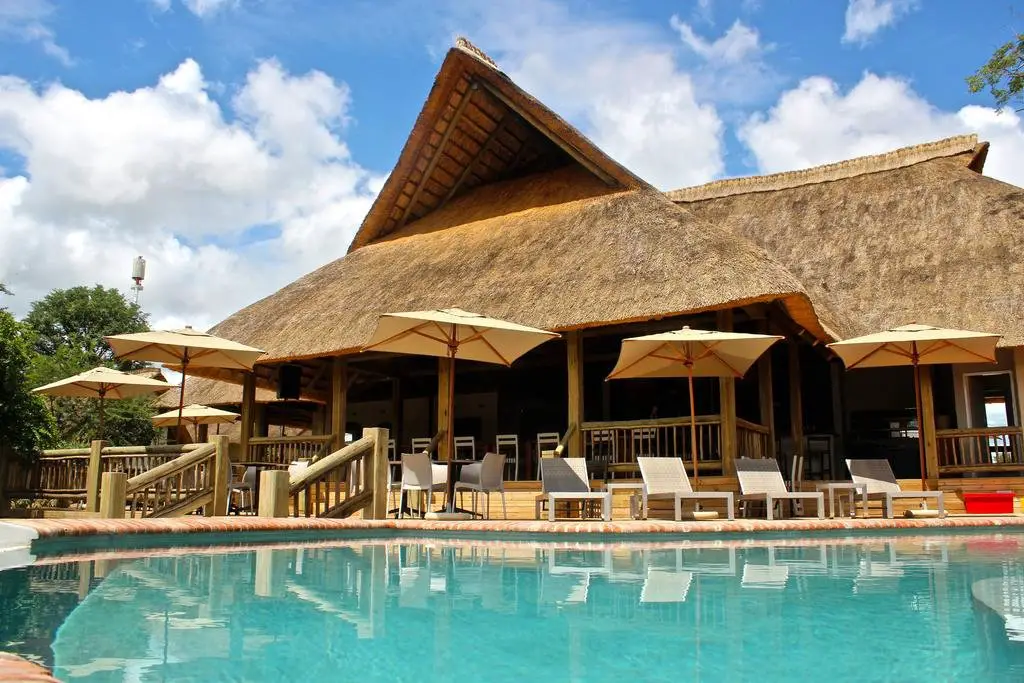
#3 Victoria Falls Safari Lodge
The breathtaking Victoria Falls Safari Lodge offers easy access to Victoria Falls, a natural wonder of the world. Overlooking the Zambezi National Park, this safari lodge features a restaurant, Buffalo bar overlooking a waterhole, and more. It’s no wonder the Victoria Falls Safari Lodge has been voted 20 years in a row as the best safari lodge.
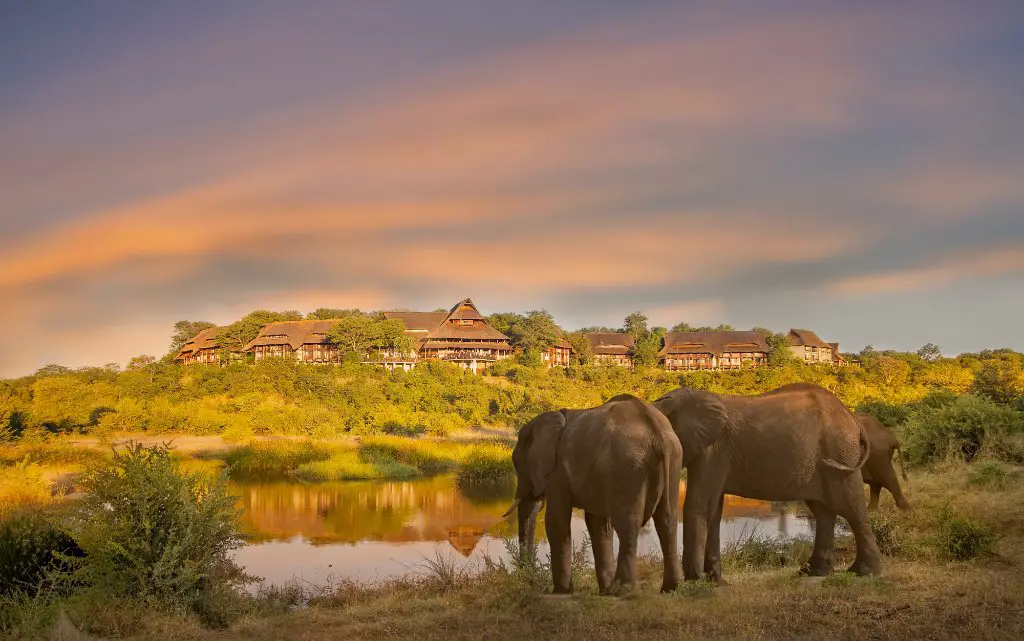
#4 Meikles Hotel
This 5-star luxury hotel is located in the Central Business District and features a large pool, airport transportation, fitness center, and even babysitting service. A 2013 revitalization renewed the charm of the legendary hotel.
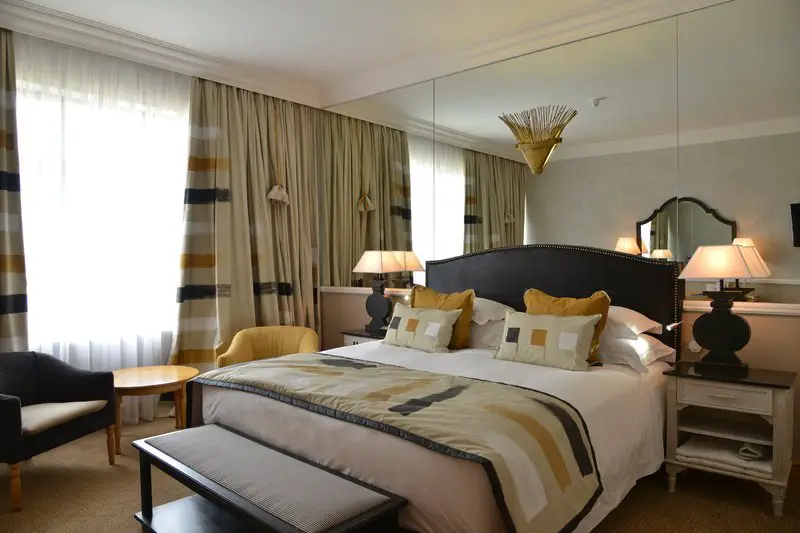
#5 Rainbow Towers Hotel And Conference Center
Located in the business district of Harare, the Rainbow Towers Hotel and Conference Centre offers access to the business center, fitness center, elaborate pool and bar area and more.
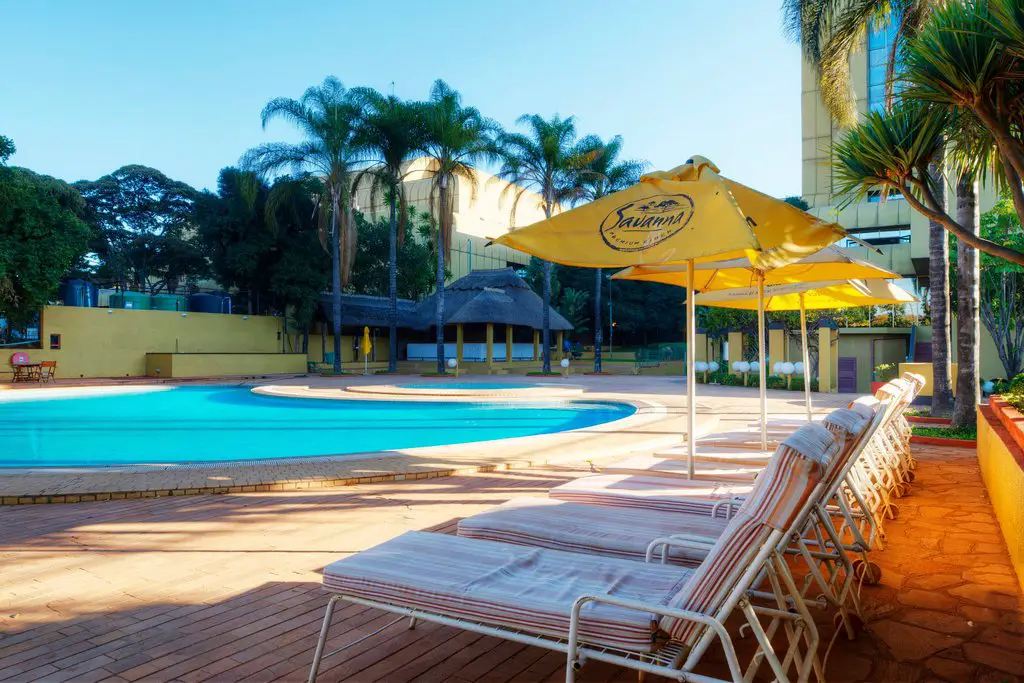
Best Things to Do in Zimbabwe
#1 Safari in the Zimbabwe National Parks
An African adventure can never be complete without a safari. The two most significant Zimbabwe national parks are Hwange and Matopos. These African national parks offer an exciting collection of animal encounters, game drives, and walking safaris are both possible in these destinations.
#2 Visit the Great Zimbabwe Ruins
Zimbabwe’s cultural heritage from the Medieval Era is surprisingly intact, especially the Great Zimbabwe Ruins near Lake Mutirikwe. The ancient capital of the Kingdom of Zimbabwe has ancient ruins dating back to the 11th- 15th centuries, consisting of distinct dry-stone houses.
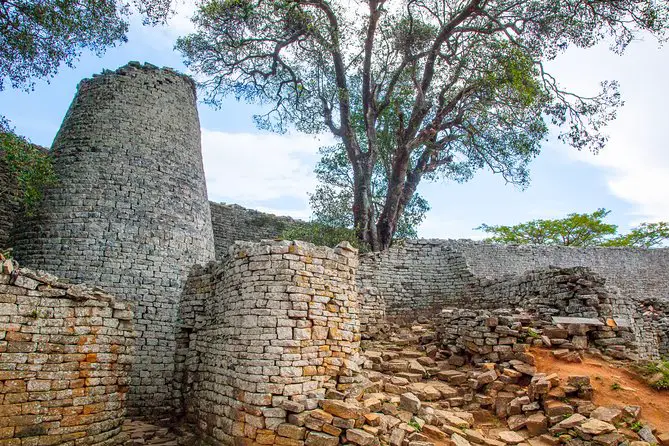
This UNESCO Heritage Site is one of the biggest ancient cities you will ever see in African countries.
#3 Watersports Around Zambezi River
The Great Zambezi River at the border of Zimbabwe and Zambia is the source of both the famous Victoria Falls and many adventurous water sports around the area. You can participate in activities from fishing to rafting and rock-climbing.
Best Things to See in Zimbabwe
#1 Victoria Falls
The Smoke That Thunders, Victoria Falls is considered the largest sheet of falling water in the world. With a height of 108 meters, it is twice as high as Niagara Falls.
The picturesque waterfall and the surrounding Victoria Falls National Park is a massive wildlife area and a rich rainforest.

Although the Zambian Site is more touristic nowadays thanks to the town Livingstone, you should not underestimate the Zimbabwean side.
#2 Granitic Boulders at Matapos National Park
Matabo National Park is well-known for its granitic boulders where you will feel like you are on another planet. Not only these rock formations picturesque, but they are also historically valuable for the Bushmen paintings that they preserved.

#3 Bulawayo and Mutare Town
Zimbabwe’s historic towns will impress you with their quaint atmosphere and vintage architecture.
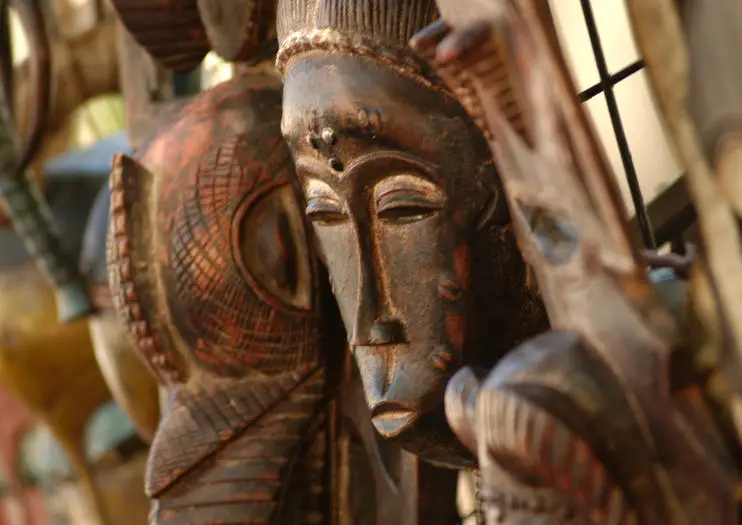
Bulawayo’s National Museum and the Railway Museum are very informative about the country’s history. Mutare Town is another successful demonstration of Zimbabwean culture and art.
We have more ideas on 9+ absolute best things to see and do in Zimbabwe. You will love #5.
Best Places to Eat in Zimbabwe
#1 Amanzi Restaurant
#2 Victoria 22 Restaurant
#3 Alo Alo Restaurant
Typical Costs
Average Flight Cost: $925 – 1,400 Set low fare price alert for Zimbabwe!
Accommodation
Camping: $7-8 per person per night Guesthouse: $20 – $50 per night for a standard room Hotel: $50 – $150 per night
Local meal: $5 – $7 Meals at a popular restaurant: $10 – $25 Beer: $2 – $3 Bottle of Water: $0.7 Bottle of Coke: $1
Transportation
Intercape Bus from Harare to Bulawayo: $30 1-2 hours of bus ride within the cities: $10 – $12 Hiring a private taxi: $50 – $80 per day
Victoria Falls Entrance Fee: $30 Matopos Entrance Fee: $15 The Great Zimbabwe Ruins Entrance Fee: $15 Game drive in national parks: $40 per person All-inclusive safari (accommodation, meals, activities): $600 – $800
Total Travel Cost
Expect to spend between on average between $1,500 to $2,500 depending on the number of days you plan on visiting the country. The cost of a luxury trip is two to three times the average cost, and for budget-friendly or backpackers, spending under $1,500 is very realistic.
Zimbabwe Travel Tips
Weather in zimbabwe.
The winter or wet season is from November to April with peak rainfall in March and April. From July to October is the summer or dry season with mostly sunny days and cold nights.
Best Months to Visit (When to Visit)
The peak season starts in July and continues until September. This time of the year is a popular time to visit Zimbabwe because wildlife viewing is the easiest. It is also the ideal time for canoeing and rafting in the Zambezi River. However, it is also much more crowded compared to the rest of the year, so you might want to wait for October for the tourists to go back to their 9-5 jobs.
How to Save Money in Zimbabwe
- Besides the Small World Backpackers Lodge in Harare and Shoestrings in Victoria Falls, the backpacker scene hasn’t developed much. The other cheap form of accommodation is camping. It is best to bring your own tent, as you might not always find spare tents at the campsite.
- Instead of using luxury buses like Intercape, you can use the local buses between cities to save up on transportation.
- Visiting during the winter (wet) season will save you between $500 to $1,500 on flight and accommodation.
Safety Tips: What You Need to Know About Zimbabwe Travel
- The political unrest is still ongoing in the big cities, even after the resignation of President Mugabe. There might be occasional violent protests, especially in Harare.
- Petty theft is common in the cities, so do not go out alone at night. Also, try not to flash your valuables or look like a confused tourist with a map on one hand and a safari hat on the other.
- You must not disturb/feed/engage with the animals during the safari drives. This is critical both for your own safety and for the well-being and comfort of the animals.
- Zimbabwe is a Malaria-risk region, so we suggest that you consult your practitioner before you travel. For detailed information on vaccinations needed, visit here .
Culture & Customs
Zimbabwe has 16 official languages: Chewa, Chibarwe, English, Kalanga, Khoisan, Nambya, Ndau, Ndebele, Shangani, Shona, sign language, Sotho, Tonga, Tswana, Venda, and Xhosa.
The three most common ones are Shona, Nbedele, and English. The white farmers, who are a minority in the country, also speak Afrikaans and some European languages.
The most common currencies are Zimbabwe Dollars and US Dollars as the primary foreign currency. For detailed information about the exchange rates and how tourists can pay, visit here .
It’s customary to leave a 10% tip at the restaurants, as well as giving $1-2 to the car guards. Safari guides will also appreciate tips as well.
There are abundant of wildlife to view in Zimbabwe at the national parks or on game reserves. Ever since the Wildlife Conservation Act in 1960, the wildlife in this Southern African country has shown significant improvement.
There is an increasing population of buffalo, elephant, rhinoceros, giraffe, leopard, lion, zebra, and antelope around the country.
Getting Around Zimbabwe
Surprisingly, you have access to trains between the main tourist destinations . The most popular train route is between Bulawayo and Victoria Falls through Hwange National Park.
There are two types of buses: The Intercape and the local buses. The latter is cheaper and much less comfortable. See the travel costs section for transportation price information.
Private shuttle and road transfer companies like Wild Horizons and Safari Logistics provide comfortable transportation to the national parks.
Entry & Exit Requirements
To visit Zimbabwe, you will need a passport that is valid for at least 6 months on the date of entry. Reservations, travel insurance and return tickets are also required.
There are three types of scenarios for Zimbabwe visa requirements , depending on your home country:
- You don’t need a visa (including SADC countries like South Africa)
- You can obtain a visa on arrival
- You have to apply for a visa beforehand.
For the lists of countries in all three categories, visit here .
Individuals from certain countries can obtain Univisa, which allows them to travel to both Zimbabwe and Zambia for $50. This can be purchased at Victoria Falls or David Livingstone Airport. Check here for the list of eligible countries.
We hope you found our detailed Zimbabwe travel guide helpful. To help you get started on your trip, check out our travel guides , Zimbabwe Packing List , and the additional resources below.
Love it? Pin it!

Related Articles for Zimbabwe
Follow us around the world, our next destination.
Fez, Morocco
Must-see attractions in Zimbabwe
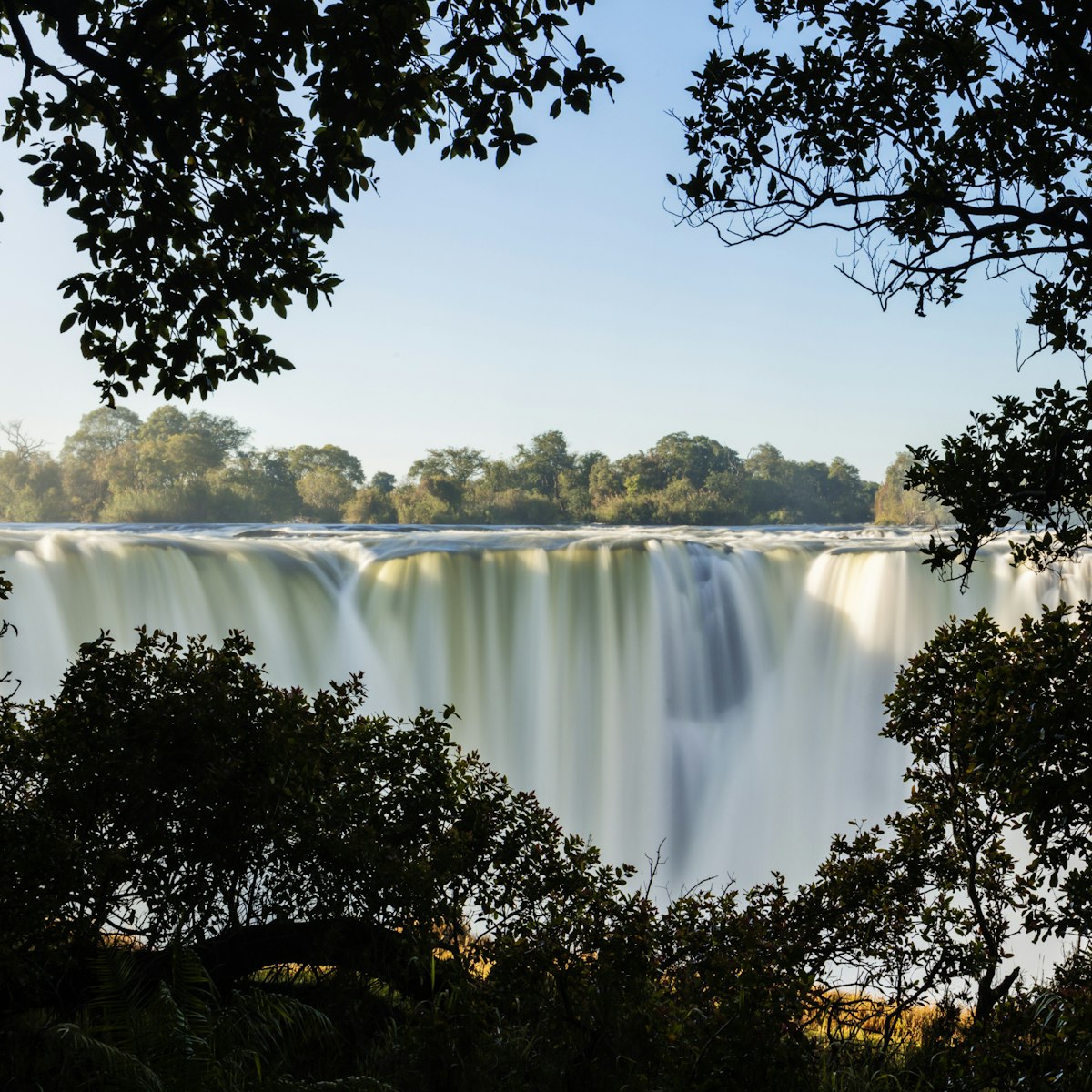
Victoria Falls National Park
Victoria Falls (town)
Here on the Zimbabwe side of the falls you're in for a real treat. Some two-thirds of Victoria Falls are located here, including the main falls themselves…
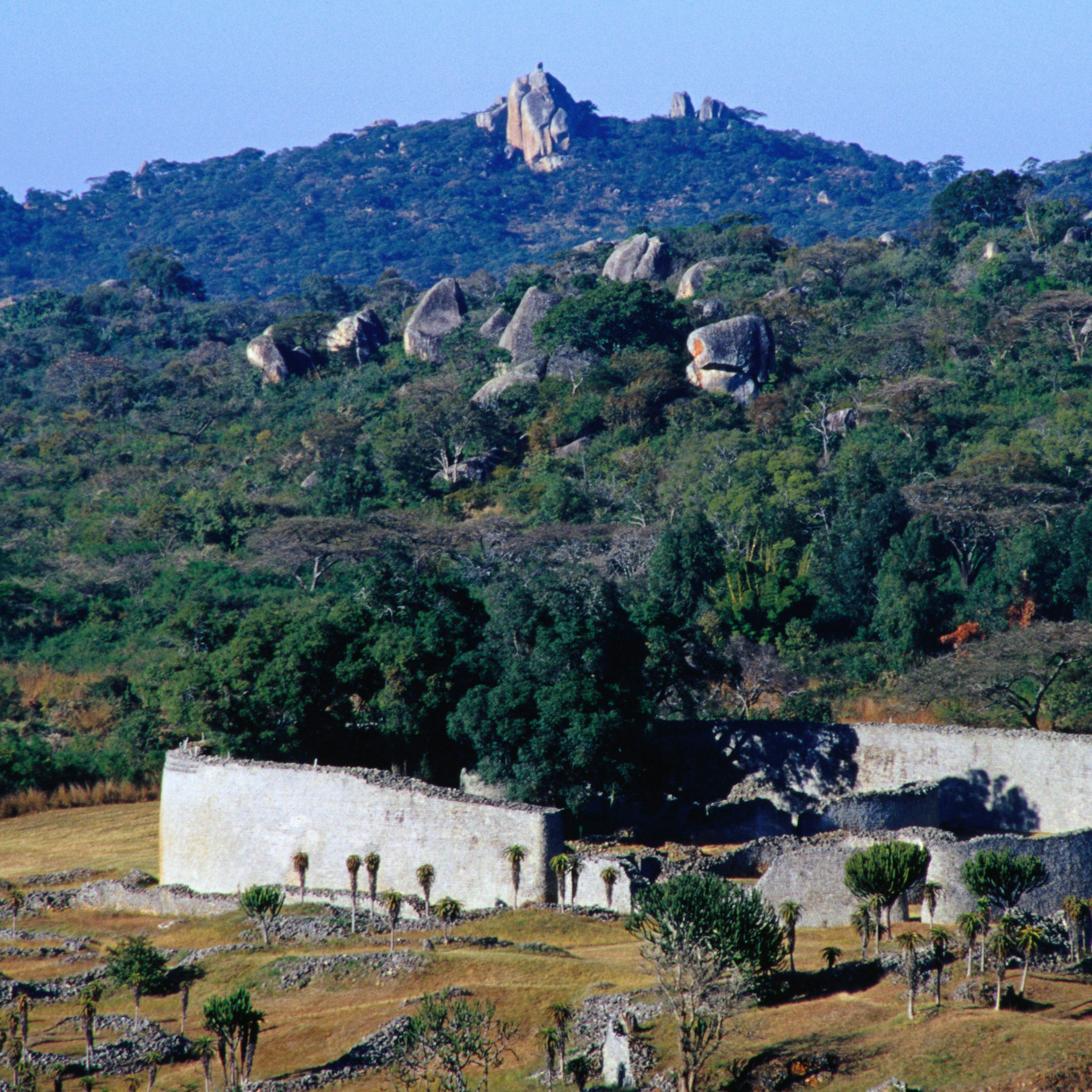
Great Zimbabwe
The mysterious ruined city of Great Zimbabwe dates back to the 11th to 15th centuries AD and remains the emblem and heart of the nation. The Unesco World…
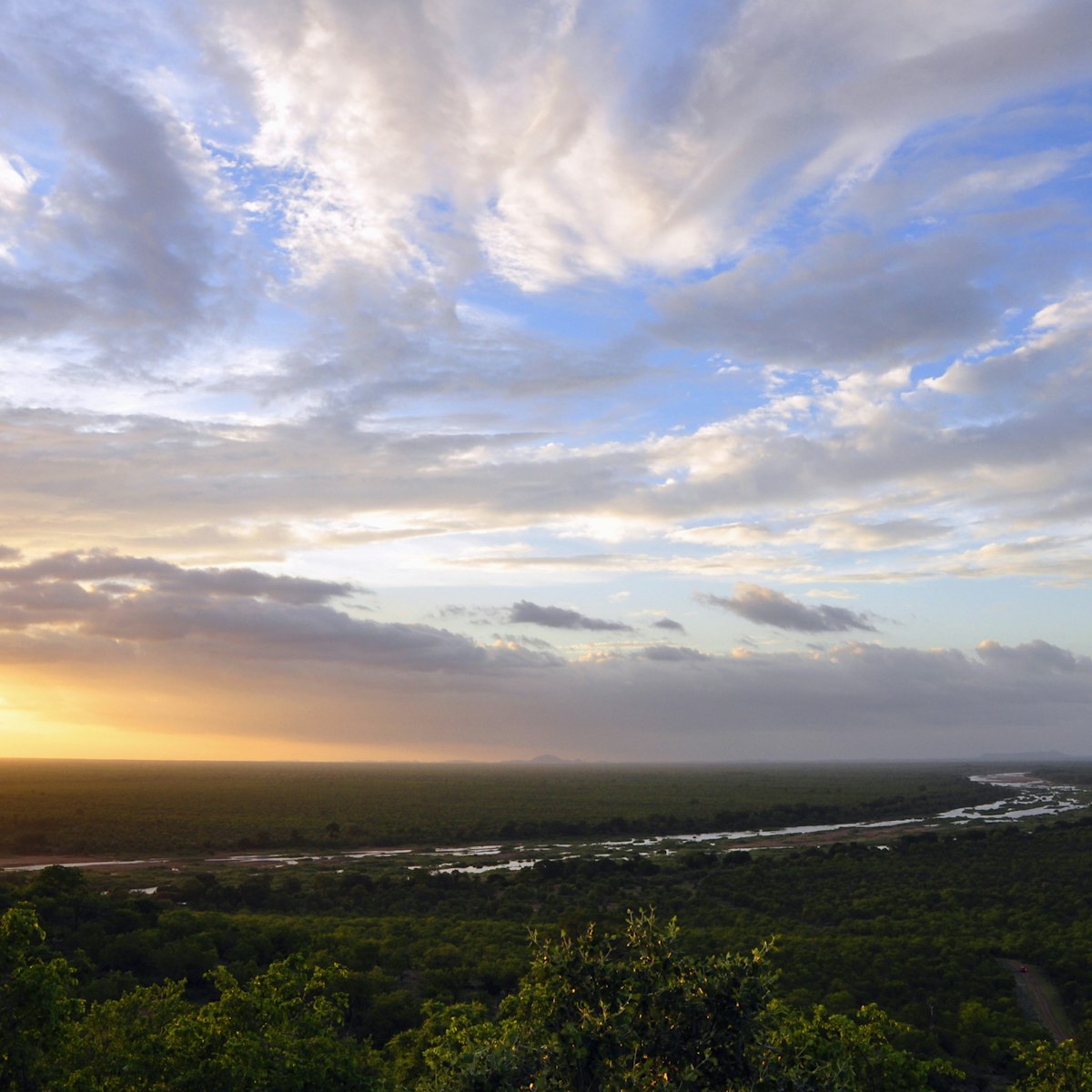
Gonarezhou National Park
Hidden in the southeast corner of the country is the stunning Gonarezhou National Park, ZImbabwe's second largest park (5000 sq km) and regarded by many…
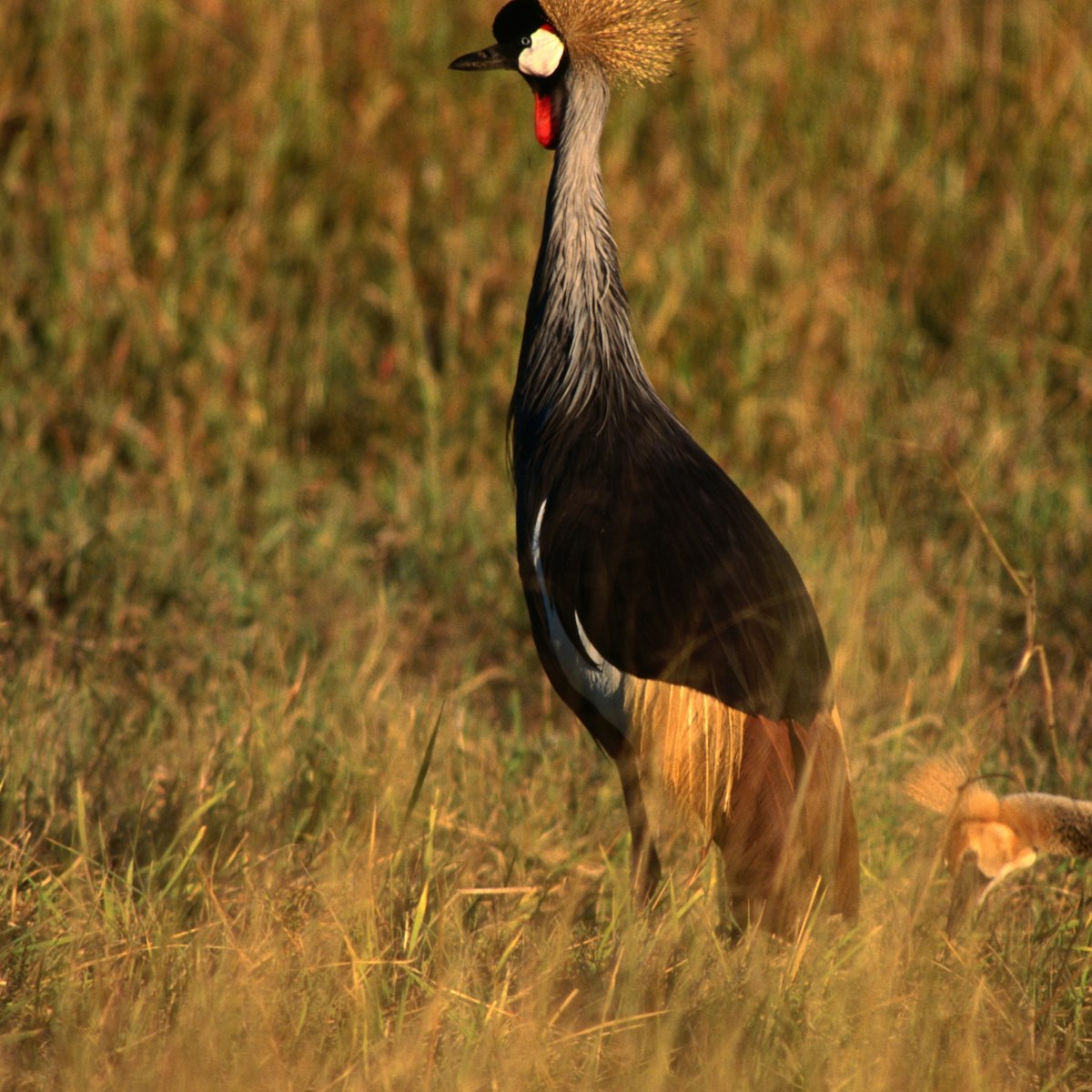
Hwange National Park
One of the 10 largest national parks in Africa, and the largest in Zimbabwe, at 14,651 sq km, Hwange National Park, pronounced ‘Wang-ee’, has a ridiculous…
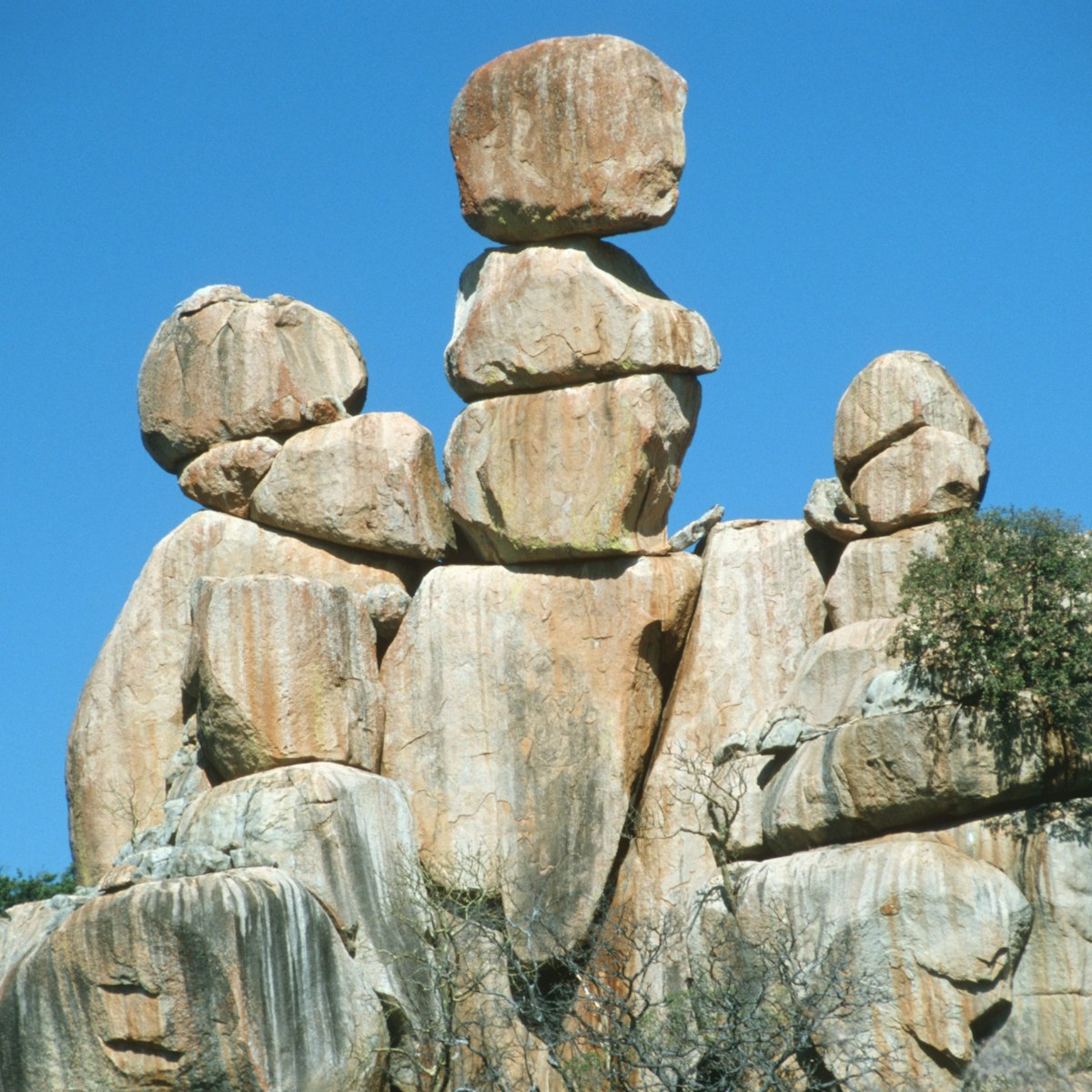
Matobo National Park
Home to some of the most majestic granite scenery in the world, the Matobo National Park is one of the unsung highlights of Zimbabwe. This Unesco World…
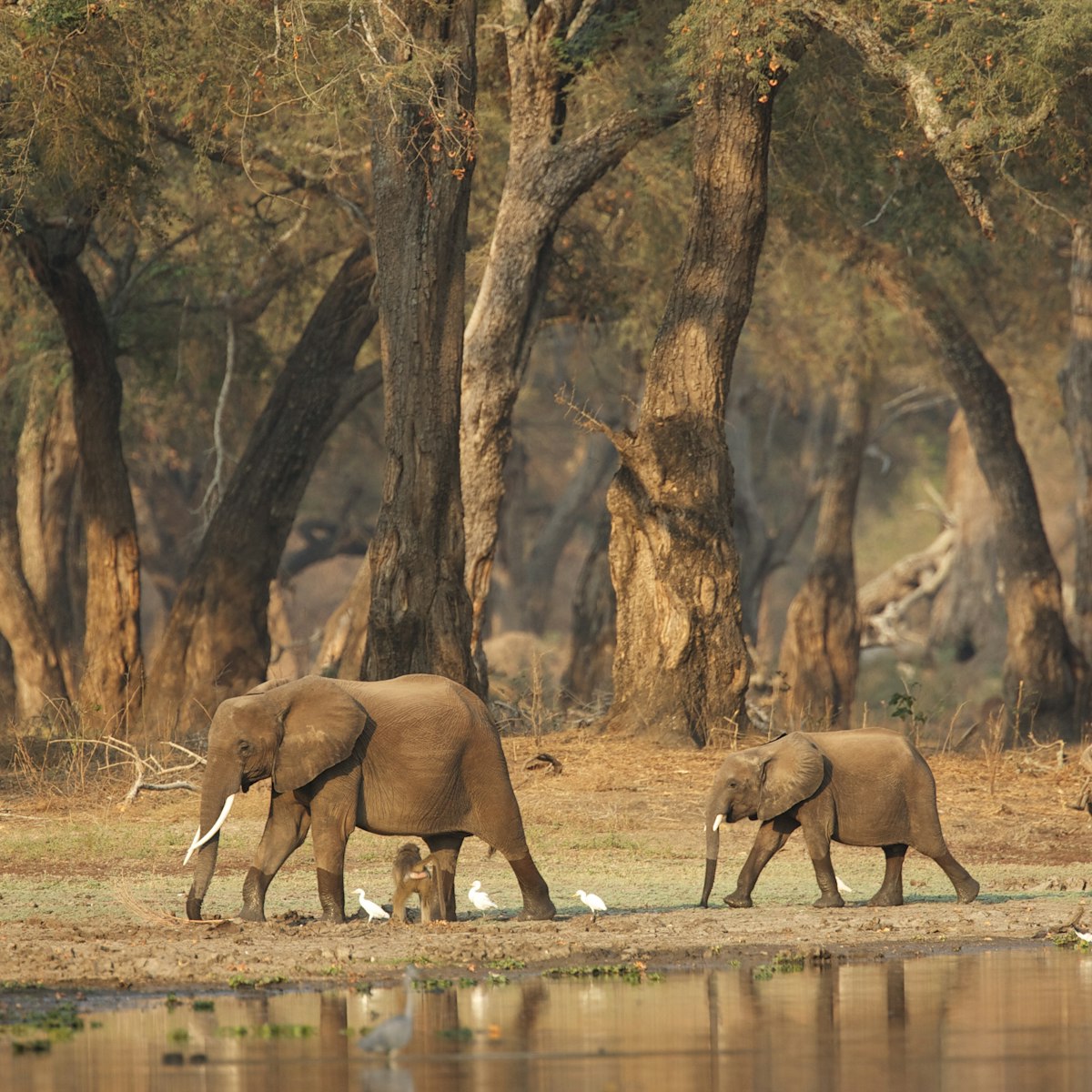
Mana Pools National Park
This magnificent 2200-sq-km national park is a Unesco World Heritage–listed site and its magic stems from its remoteness and pervading sense of the wild…
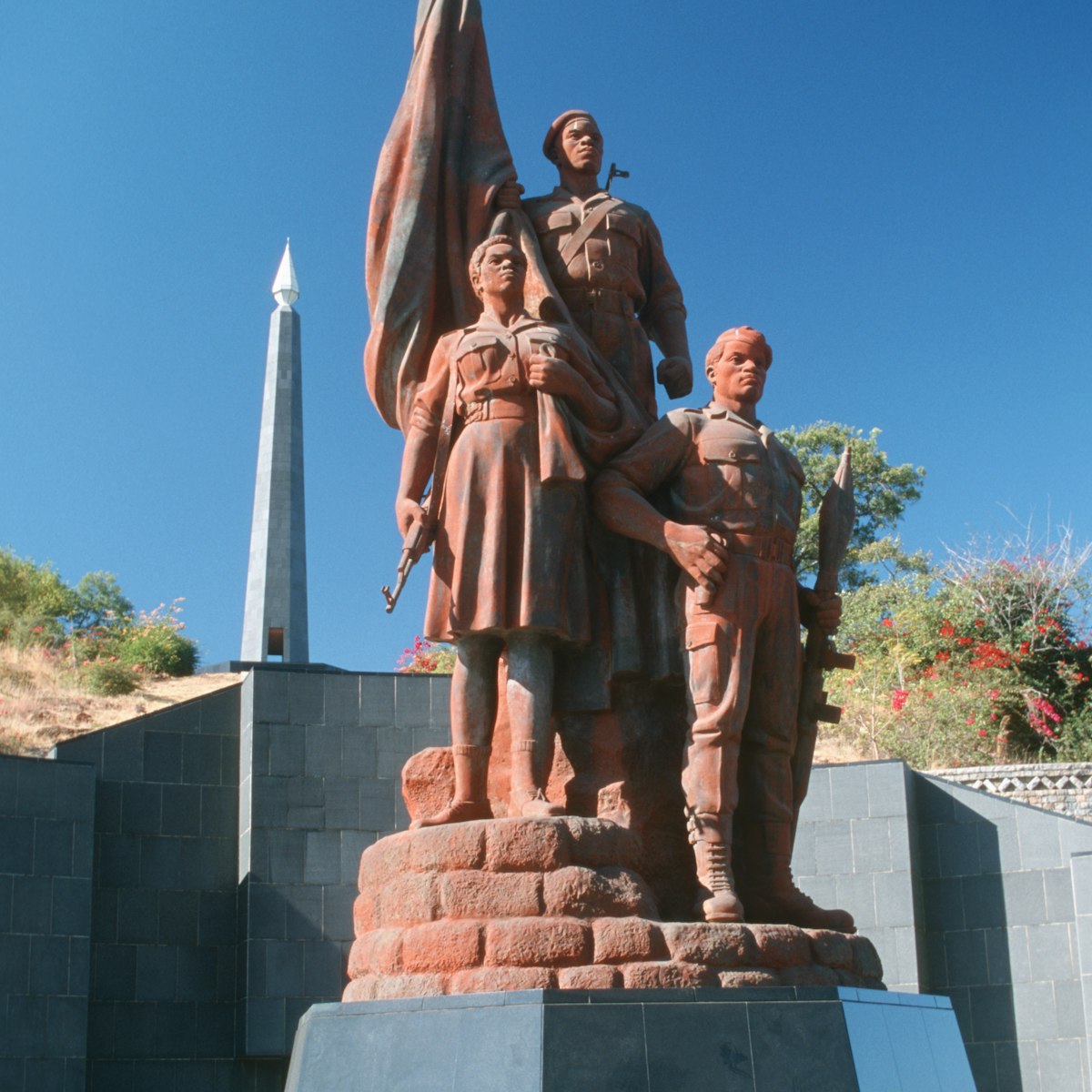
National Heroes' Acre
The grandiose obelisk of Heroes' Acre, overlooking the town, is straight out of Pyongyang, yet lies just 7km from Harare. Designed with the assistance of…

Natural History Museum
Zimbabwe's largest and best museum makes for an essential visit. Set over three floors, it offers a great overview of the country's natural,…
National Gallery of Zimbabwe
In the southeast corner of Harare Gardens, this lovely gallery has multiple spaces exhibiting a mix of contemporary local, African and international…
Jafuta Heritage Centre
This impressive little museum details the cultural heritage of Zimbabwe's indigenous ethnic groups. There's good background information on the Shona,…
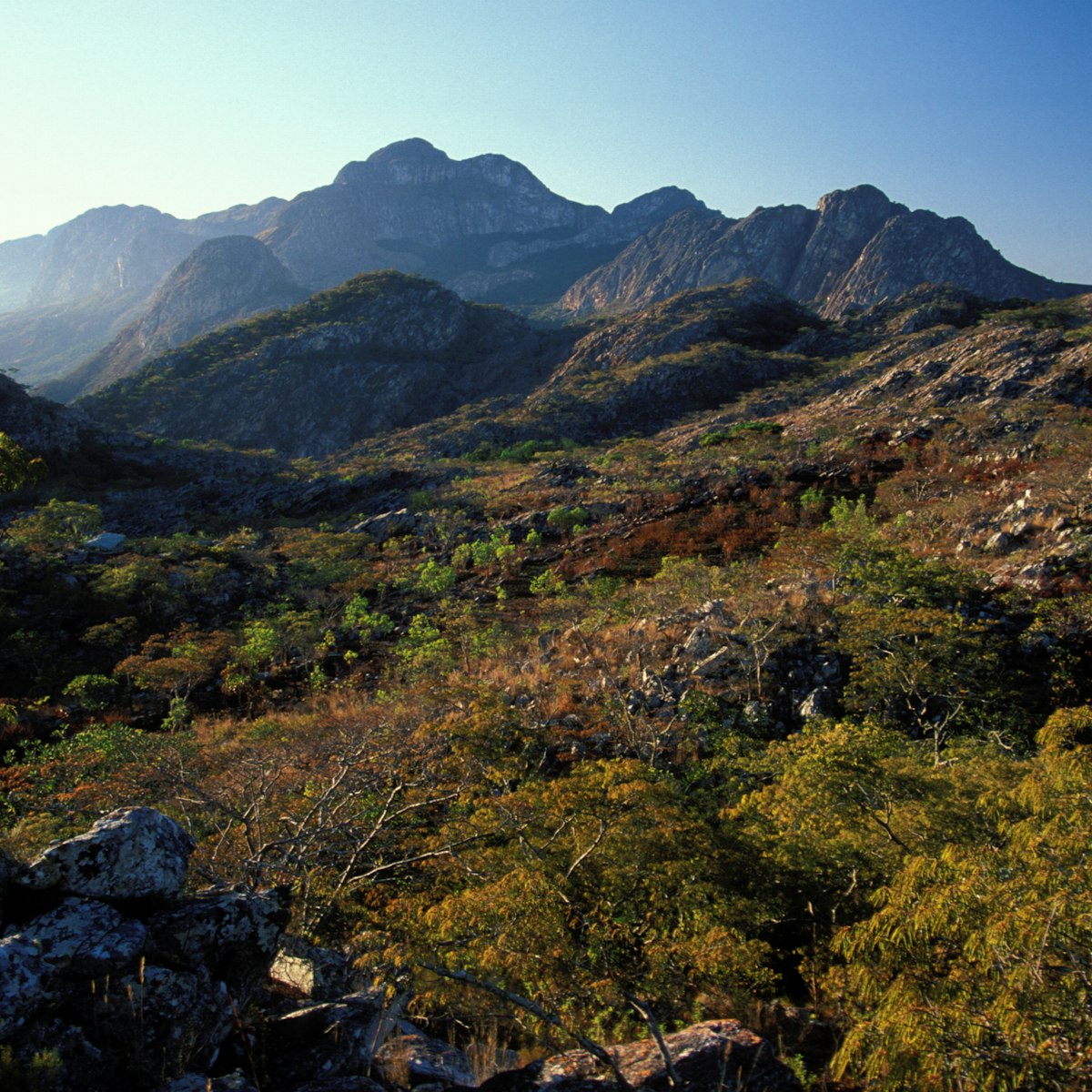
Chimanimani National Park
With its pristine wilderness, Chimanimani National Park is a hiker's paradise. Sharing a border with Mozambique, the park is still very wild and unspoiled…
Khami Ruins
Just 22km from Bulawayo, the Unesco World Heritage–listed Khami Ruins may not have the grandeur of Great Zimbabwe, but it's an impressive archaeological…
World's View (Malindidzimu Hill)
One of Zimbabwe's most breathtaking sites, the aptly named World's View takes in epic 360-degree views of the park. The peacefulness up here is immense,…
Bulawayo Railway Museum
Whether you're a train enthusiast or not, Bulwayo's Railway Museum rarely disappoints. Its passionate curator, Gordon Murray, will take you on a tour of…
Chilojo Cliffs
In addition to wildlife, another of Gonarezhou's major drawcards are its majestic Chilojo Cliffs. These spectacular red-and-white banded sandstone columns…
Rock Art Caves
Dotted around the 425-sq-km Matobo National Park are 3000 officially registered rock-art sites, including one of the best collections in the world of San…
Matusadona National Park
Situated on the southern shore of Lake Kariba, the beautiful Matusadona National Park is home to the Big Five, including the endangered black rhino. While…
National Art Gallery
Set in a beautiful 100-year-old, colonial, double-terrace Edwardian building, the National Art Gallery shows temporary and permanent exhibitions of…
Delta Gallery
A must for contemporary art lovers is this gallery inside the charming colonial house of eminent Rhodesian painter Robert Paul (1906–79). It showcases…
These National Monument ruins of communities who specialised in pottery date to AD 200 and are one of Zimbabwe's more impressive archaeological sites. The…
Wild is Life
A wildlife sanctuary with a difference – sip on afternoon tea and champagne while getting a hands-on experience with the injured, rescued or orphaned…
Tengenenge Art Community
A must for those in interested in Shona sculpture, as well as traditional Zimbabwean culture, the Tengenenge Art Community overall makes for a rewarding…
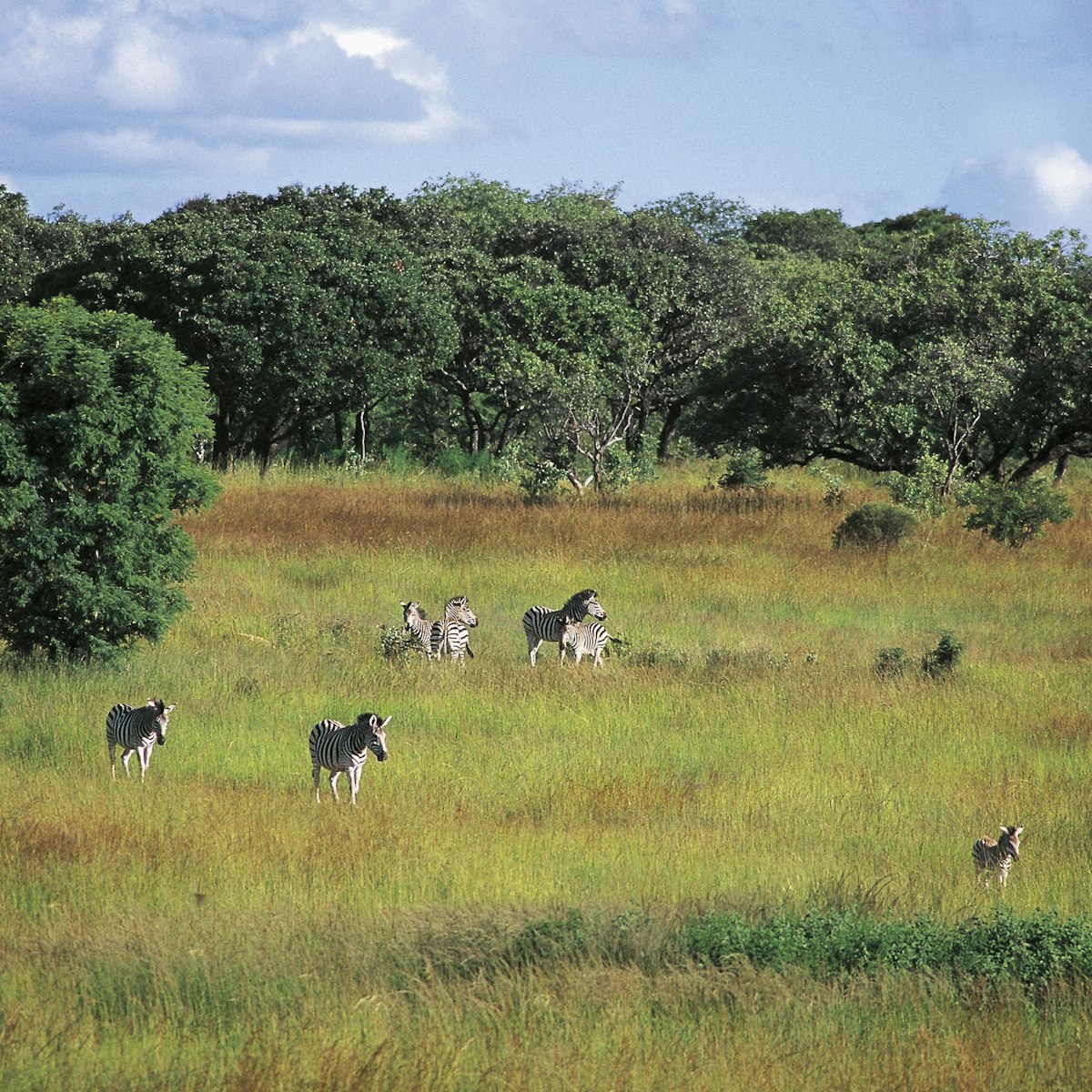
Mukuvisi Woodlands Environmental Centre
Only 7km from the city, most of the 265 hectares here are natural msasa parkland where zebras, giraffes and antelope species roam free. View from the…
Lake Chivero Recreational Park
Only 32km from the capital, Lake Chivero is one of the best places in Zimbabwe to spot rhinos in the wild. Run by the national parks, it's home to several…
Nyanga National Park
Scenic and secluded, beautiful Nyanga National Park is 100km north of the Bvumba, the central mountains of the Eastern Highlands. Some parts may remind…
Bushman Rock Safaris
Part winery, part game reserve, part polo field, part boutique lodge: Bushman Rock has a number of faces to it. The vineyard was established in the 1930s…
Lake Kyle (Mutirikwi) Recreational Reserve
Originally called Lake Kyle but now officially know as Lake Mutirikwi is this man-made lake created as a dam in 1960 to irrigate the lowveld sugar cane…
Painted Dog Visitor Centre
An interesting place to visit in-between safaris or en route to the park is this NGO, which works towards the protection of the critically endangered…
National Botanic Gardens
If you thought Harare couldn't get any more relaxed, you clearly haven't visited its botanical gardens. Spread over 68 hectares, it's an extremely…
National Archives of Zimbabwe
Founded in 1935, this building is the repository for the history of Rhodesia and modern Zimbabwe. It's worth a visit to see artefacts, photos, accounts of…
Zambezi National Park
Just 5km from the town centre is this vastly underrated national park, comprising 40km of Zambezi River frontage and a spread of wildlife-rich mopane …
Church of Santa Barbara
This circular, hilltop, Italian-built church was built in the memory of 86 African and Italian construction workers who lost their lives while building…
Eastgate Centre
Inspired by the ruins of Great Zimbabwe, the Eastgate Centre shopping complex is noteworthy for its sustainable design based on a termite mound, which…
Black mambas, spitting cobras and puff adders ain't things you want to come across in the wild, so fortunately they're all here to see behind the safety…
Chinhoyi Caves Recreational Park
Located 4km north of Chinhoyi, along the main highway (135km from Harare), this cave network is worth a stop for its underground lake that's coloured a…
Tobacco Floor
Not quite the NY stock exchange but certainly fast paced. Get among the action on the floors where farmers on one side sell bales of tobacco to brokers on…
Cecil Kop Wildlife & Nature Reserve
Only 2km from Mutare, this low-key nature reserve is definitely worth a visit if you're hanging around town. Set over 1500 hectares, it's home to…
Kariba Dam Wall
Forming the border between Zambia (Siavonga) and Zimbabwe is the Kariba dam wall. It's an impressive engineering feat that you can walk the length across;…
Rhodes Nyanga Historical Exhibition
The Nyanga Historical Exhibition is housed in Cecil Rhodes' (1853–1902) former stables in the grounds next door to the Rhodes Nyanga Hotel. It has a…
Dam Observation Point
Head up to Observation Point for excellent sweeping views of the lake and Kariba Dam. The Kariba Publicity Association is based up here and it houses some…
More destinations you need to see
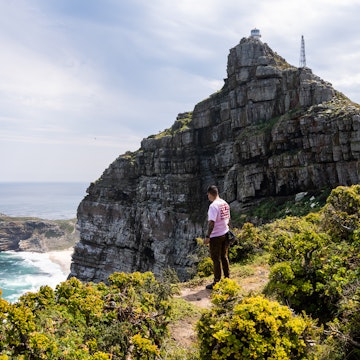
- 3 Other destinations
- 4.1 History
- 4.2 Climate
- 4.3 Terrain
- 4.4 Culture
- 4.6 Economy
- 4.7 Holidays
- 4.8 Tourist information
- 5.1.1 Category A - no visa required
- 5.1.2 Category B - visa on arrival
- 5.1.3 Category C - visa before arrival
- 5.1.4 KAZA universal visa
- 5.2 By plane
- 5.5 By train
- 6.2 By taxi
- 6.3 By train
- 6.5 By hitchhiking
- 8.1 Urban life
- 11.1 Specialities
- 14.1 Police
- 14.2 Road safety
- 15 Stay healthy
Zimbabwe is a landlocked country in Southern Africa . For those looking to travel in Africa , Zimbabwe is a great starting place. It is rich in fauna (being home to the big five) and flora and has numerous ancient stone cities including the largest in Africa south of the Sahara, Great Zimbabwe . Its border with Zambia is formed by the Zambezi River which when in full flood drops as the world's largest curtain of falling water at the mighty Victoria Falls which is a major tourist attraction.
Regions [ edit ]
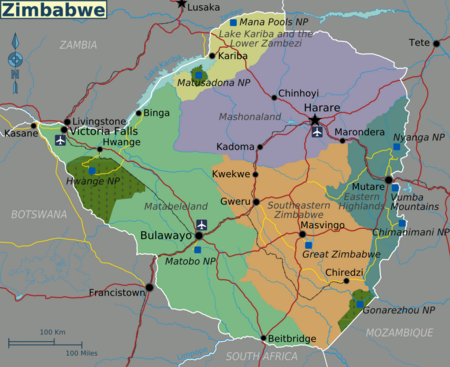
Cities [ edit ]

Zimbabwe has 4 large cities and several smaller ones.
- -17.829167 31.052222 1 Harare — the capital and the largest city in Zimbabwe, Harare is a vibrant city in a larger metropolitan province
- -20.166667 28.566667 2 Bulawayo — the second largest city with historic Victorian, Edwardian and midcentury architecture. It is the second city, both by population and economic activity
- -20.183333 32.866667 3 Chimanimani - Gateway to the Eastern Highlands
- -19.458 29.82 4 Gweru - Located in the centre of the country close to the Danangombe ruins. Also the capital of the Midlands Province
- -16.533333 28.8 5 Kariba — a lakeshore holiday resort on border with Zambia
- -20.074444 30.832778 6 Masvingo — named (meaning "ruins") after the nearby Great Zimbabwe National Monument
- -18.972778 32.669444 7 Mutare - the major city closest to the scenic Eastern Highlands and the Mozambique coast.
Other destinations [ edit ]
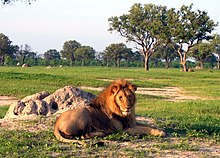
- -21.666667 31.666667 2 Gonarezhou National Park - Tucked in an isolated corner of Zimbabwe, much of the park remains pristine wilderness
- -20.27 30.933 3 Great Zimbabwe - The archaeological remains of an ancient city built of stone (the largest in Southern Africa), that was the capital of a vast empire known as the Munhumutapa Empire (also called Monomotapa Empire) covering the modern states of Zimbabwe (which took its name from this city) and Mozambique. The word 'Zimbabwe' means 'house of stone.'
- The Eastern Highlands include some of Zimbabwe's most beautiful views. The lush, cloud-hung mountains form the border with Mozambique . The regional capital is Mutare, and Chimanimani is a village popular with tourists and walkers.
- -16.533333 28.8 4 Kariba - The formidable Lake Kariba on the northern border of Zimbabwe is the result of a large damming project along the Zambezi River. Kariba is a popular tourist destination and affords visitors the opportunity to watch African wildlife in its almost natural environment. It is the biggest source of hydro-electric power for Zimbabwe. If you are travelling with friends or family consider hiring a houseboat for a few days to really experience everything the lake and the wildlife have to offer.
- The rocks are home to the dassie, a small rodent-type animal known more formally as Rock Hyrax, the skins of which are used to make a blanket treasured amongst the local populace. Also present in great numbers are the brightly coloured lizards common to Zimbabwe. The area has two large dams and many smaller ones that become the scene of family picnics, and angling competitions on weekends. A game park is home to herds of sable antelope, an animal not seen further south. The National Park boasts self catering chalets with amazing views as well as camping sights.
- Matobo is also the sight of Cecil John Rhodes' grave and some exquisite cave paintings.
- -17.065353 30.706956 6 Mutoroshanga Ethel Mine
- -17.35 30.2 7 Chinhoyi Caves
Understand [ edit ]
History [ edit ].
Stone cities were built in many locations in present-day Zimbabwe. The most impressive structures and the best known of these, Great Zimbabwe, were built in the 15th century, but people had been living on the site from about 400 AD. The Khami Ruins just outside Bulawayo are also a wonderful example.
The population was overwhelmingly made up of Shona speakers until the 19th century when the Nguni tribe (in 1839-40) of the Ndebele settled in what is now Matabeleland, and then in 1890, the territory came under the control of the British South Africa Company under charter from the British Government.
The United Kingdom annexed the land, then called Southern Rhodesia, from the British South Africa Company in 1923, when the country got its own government and Prime Minister. A 1961 constitution was formulated that favoured whites in power. In 1965, this white supremacist government unilaterally declared independence as Rhodesia, but the UK did not recognize the act and demanded voting rights for the black majority. UN sanctions and a guerrilla struggle finally led to free elections and independence (as Zimbabwe) in 1980.
Robert Mugabe became the first democratic leader of Zimbabwe. While initially lauded for his talk of reconciliation and his government's investment in education, healthcare and infrastructure, he slowly consolidated power from 1980-1987 as prime minister, and 1987-2017 as president. Starting in 2000, the government expropriated some very productive farms, which were in the hands of white Zimbabweans, as punishment for their support of the main opposition party, the MDC and handed them over to members of corrupt members of Mugabe's ZANU party, many of whom had no interest in farming, resulting in a drastic falloff in local food production. In 2005, he started a program which cleared slums, forcing hundreds of thousands of people onto the street.
Rigged elections and human rights abuses led to widespread emigration and international sanctions. Eventually, misrule and sanctions triggered massive, runaway inflation and a third of the population to choose to migrate. Elections were routinely marred by violence, directed by the ruling ZANU-PF party against opposition supporters. Following widespread protests, a power-sharing agreement was signed between President Mugabe and the leader of the main opposition party, Morgan Tsvangirai, in 2008. This briefly stabilized the political situation, but continued inflation led to the withdrawal of the Zimbabwe dollar from circulation in 2009; at the end, 100 trillion Zimbabwe dollars would not buy a loaf of bread. The defunct Zimbabwe dollar was replaced by a basket of currencies and ultimately adoption of the US dollar. The coalition government ended with Tsvangirai's 2013 electoral defeat in what was widely held to be a rigged election. By 2016 currency shortages were common, with the Reserve Bank of Zimbabwe directing banks to limit withdrawals to US$20-50/day or US$150/week. In November 2016 another toy currency ("bond notes") was introduced at par with the US dollar. US cash is king, however, and the bond notes often trade at a discount if they're accepted at all. Usability of credit cards is sporadic as businesses have trouble accessing hard currency to pay for imports.
Mr. Mugabe remained President until November 2017 when, at the age of 93 with serious questions about his health, he failed in a brazen attempt to continue the family stranglehold on power by sacking the country's vice president as a first step toward installing his wife Grace as a presidential candidate for the 2018 election cycle. This led to an enraged military deposing him; most of the original veterans of the 1980 uprising against Rhodesia turned against Mugabe, with his own ZANU-PF party forcing his resignation by calling a vote in the legislature to impeach him. Mugabe was subsequently replaced by Emmerson Mnangagwa, the vice president who he had sacked.
Mnangagwa remained President when he was elected in the 2018 general elections which like the 2013 elections were widely criticized for irregularities domestically and internationally. The current government has rolled back some of the excesses of Mugabe, and declared the country "open for business", as well as a proposal to re-join the Commonwealth, but his time in office has not been free of strife: in 2019, widespread protests that were held after the government announced a 130% rise in fuel prices were met by violence from the police and military. However, it is not all gloomy: the government has led the continent in its vaccine programme, besting its larger and wealthier peers.
Climate [ edit ]
Zimbabwe has an excellent subtropical highland climate that is moderated by altitude. The rainy season is in summer from November to March. Although there are recurring droughts, floods and severe storms are rare. Winter temperatures can drop below 5° Celsius whilst summers can be very hot, they rarely go over 32°C (90°F), with the exception of lower regions of the country such as the Zambezi valley.
Terrain [ edit ]
Mostly high plateau with higher central plateau (high veld). There is a mountain range in east including the scenic Chimanimani mountains. The Lowveld is found in south eastern corner.
Elevation extremes : lowest point: junction of the Runde and Save rivers 162 meters highest point: Inyangani 2,592 m
Culture [ edit ]
Owing to Zimbabwe’s ethnic diversity, varied geography, history and history of immigration, the country’s culture is rich and diverse. It has several regional variations, and despite being mostly unified by language and culture, some regions have distinct practices.
Music plays an important part in Zimbabwean identity. Styles like sungura , jazz , gospel, urban grooves and Zimdancehall are considered genuinely Zimbabwean. Sungura music is the national equivalent of roots music. Zimdancehall, which mixes several national styles with Jamaican dancehall and reggae and has become popular with the youth nationwide. New urban styles include dance music inspired by house music. Additionally, most Zimbabweans are familiar with and fans of Western popular music.
ZBC is the country's public broadcaster and somewhat analogous to the BBC in the UK. In addition, Zimbabweans increasingly have access to many other cable or satellite TV channels. Half of households have satellite TV, which is the most important source of information and entertainment for most Zimbabweans, however this trails the internet largely accessed via cell phone and accessible to most of the population, universally so in cities and among young people.
The Zimbabwe Bird is the official symbol and legendary icon of Zimbabwe. The design originates from soapstone sculptures found in the ruins of Great Zimbabwe and exists on primarily on emblems, including its national flag.
People [ edit ]
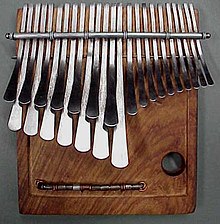
Zimbabwe is a mix of different cultures with their own beliefs and ceremonies, including the Shona, Zimbabwe's largest ethnic group. The Shona people have many sculptures and carvings which are made with the finest materials available. Shona music is also deservedly famous. Probably the best-known Shona instrument is the mbira dzavadzimu, sometimes misleadingly called the "thumb piano" by non-Africans but actually meaning "voice of the ancestors". Mbira music contains harmony and can be a kind of shifting kaleidoscope of counterpoint and lively polyrhythms. It is very tuneful, and the mbiras are often accompanied by a rattle called a hosho. Mbira music is central to Shona culture and identity and is traditionally considered a form of worship of the ancestors.
The second largest group in the country are the Ndebele people, who are distantly related to the Zulu of South Africa, whose language is mostly intelligible with Zulu and partially so with the Xhosa language of South Africa. Although their numbers have fallen since the end of white minority rule, Zimbabwe still retains a substantial white population (mostly in and around Harare), largely of British descent, with notable minorities of Dutch, Portuguese, Jewish and Greek extraction. Other groups include Asians, coloureds (mixed race people) and immigrants from Malawi, Mozambique, Zambia, the Congo and their descendants, the majority of whom have assimilated into Zimbabwean society.
Zimbabwe also has a large diaspora mostly in South Africa, the UK, Australia, Canada, the US, Ireland and New Zealand, so don't be surprised if you run into a 'diasporan' with a Western accent and outlook during your visit, as they have become significant investors and visitors within the country's tourism and real estate sectors.
In general, Zimbabweans are a warm, easy going, open minded people. Friendship, family and hospitality are highly prized among Zimbos, and both family connections and social interactions are valued highly. To people they have met, or at least know by name, Zimbabweans are usually polite, friendly and sometimes quite generous. Zimbabweans are reputedly one of the most hospitable people in the world and foreigners are usually treated with respect and hospitality.
Whereas the roots of Zimbabwean culture are African and proudly so, Zimbabwe is still a nation that is heavily influenced by the United Kingdom, and the middle class often look to London as a source of inspiration, especially given the poor and corrupt leadership in the country. Many Zimbabweans also display an ambivalent attitude to South Africa which increasingly dominates Zimbabwe's economy and whose ruling class is seen as enabling the corrupt Mnagagwa government.
Zimbabweans speak English natively and have the highest literacy rate in Africa. That said visitors will receive a very warm welcome if they try to start conversations in Shona or Ndebele. Since the beginning of the 21st century, Zimbabwe has faced an increasing wave of immigration from China, Congo, Malawi and Mozambique as well as an exodus of many residents to the UK, South Africa, Canada and Australia.
Economy [ edit ]
Once Africa's fastest growing economy and one of its most dynamic, with a large and confident middle class, especially by developing country standards, since 2000 Zimbabwe has undergone a dramatic economic collapse and since 2010 an uneven and sometimes volatile recovery.
There had been a few signs of improvement since the formation the Mnagagwa government in 2018, but the Zimbabwean economy remained plagued by high unemployment, deindustrialisation and a growing divide between a well connected and affluent elite and the rest of the population. The new government has claimed Zimbabwe 'is open for business' and though consumer goods are now widely available and certain industries have recovered (real estate, tourism and construction), the country lags behind its neighbors to the south, a far cry from its post independence heyday.
A rebound in mineral prices, real estate and tourism and a continent-leading vaccine programme, allowed GDP to rebound by more than 5% in the 2020 according to the World Bank, but Zimbabwe remains a lower middle income country with a corrupt and affluent elite, a stretched middle class and a large unemployed youth population. Gross domestic product is lower than it was in 2000; with subsequent recovery slow and uneven. That said, the country still has decent infrastructure, especially for tourism (though upkeep can be very inconsistent), a large diaspora that invests in and remains committed to improving their home country and recent government efforts that made it easier to invest in tourism and to make it a more friendly and accessible destination.
Holidays [ edit ]
- 1 January : New Year's Day
- 21 February : National Youth Day or Robert Mugabe Youth Day
- 18 April : Independence Day
- 1 May - Workers Day
- 25 May - Africa Day
- 22 December - Unity Day
- 25 December - Christmas
- 26 December - Boxing Day
In Zimbabwe, if a holiday falls on Sunday, the next day (Monday) will automatically be observed as public day. Hence, it will be a holiday.
Tourist information [ edit ]
- Zimbabwe Tourism Authority website

Get in [ edit ]
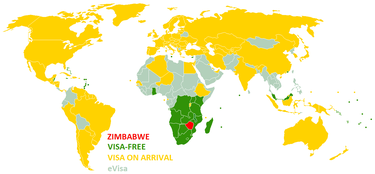
Entry requirements [ edit ]
Category a - no visa required [ edit ].
Passport holders of the following countries do not need a visa to enter Zimbabwe for up to 3 months (unless otherwise noted): Angola , Antigua and Barbuda , Aruba , Bahamas , Barbados , Belize , Botswana , Cayman Islands , Cyprus , DR Congo , Eswatini , Fiji , Ghana , Grenada , Hong Kong (6 months), Jamaica , Kenya , Kiribati , Lesotho , Madagascar , Malaysia , Malawi , Maldives , Malta , Mauritius , Montserrat , Mozambique (30 days), Namibia , Nauru , Saint Kitts and Nevis , Saint Lucia , Saint Vincent and the Grenadines , Samoa , Seychelles , Singapore , Solomon Islands , South Africa , Tanzania , Tonga , Trinidad and Tobago , Turks and Caicos Islands , Tuvalu , Uganda , Vanuatu and Zambia .
Category B - visa on arrival [ edit ]
Passport holders of the following are eligible to get a visa on arrival to enter Zimbabwe for up to 3 months (for purpose of tourism) or for up to 30 days (for purpose of business): Albania , Algeria , Andorra , Argentina , Armenia , Australia , Austria , Azerbaijan , Bahrain , Belarus , Belgium , Bermuda , Bhutan , Bosnia and Herzegovina , Brazil , British Virgin Islands , Brunei , Bulgaria , Burundi , Canada , Cape Verde , Chile , China (PRC) , Comoros , Costa Rica , Croatia , Cuba , Czech Republic , Denmark , Dominican Republic , Ecuador , Egypt , El Salvador , Equatorial Guinea , Estonia , Ethiopia , Finland , France , Georgia , Germany , Greece , Guatemala , Guyana , Haiti , Honduras , Hungary , Iceland , India , Indonesia , Iran , Ireland , Israel , Italy , Japan , Kazakhstan , Kuwait , Kyrgyzstan , Latvia , Liechtenstein , Lithuania , Luxembourg , Macao , Marshall Islands , Mexico , Micronesia , Moldova , Monaco , Netherlands , New Zealand , Nicaragua , Norway , Palau , Palestine , Panama , Papua New Guinea , Paraguay , Peru , Poland , Portugal , Romania , Russia , Rwanda , San Marino , Sao Tome and Principe , Senegal , Serbia , Slovakia , Slovenia , South Korea , Spain , Suriname , Sweden , Switzerland , Tajikistan , Turkey , Turkmenistan , Ukraine , United Arab Emirates , United Kingdom , United States , Uruguay , Uzbekistan , Vatican City and Venezuela .
Visa fees as of July 2019 at the port of entry for Category B nationals are as follows: US$30 (single entry), US$45 (double entry), US$55 (multiple entry). Cash only. A valid passport, travel itinerary, and return or onward journey ticket must be presented. Note that Canadian citizens are only able to obtain single entry visas on arrival at a cost of US$75, whilst British and Irish citizens pay higher fees for a Zimbabwe visa on arrival (US$55 for single entry and US$70 for double entry).
Category C - visa before arrival [ edit ]
Passport holders of other countries must get a visa prior to arrival to Zimbabwe.
Category C citizens may apply for a visa (for business, holiday, conferencing or transit) online through the eVisa system of the Zimbabwe Department of Immigration . Visa fee can be paid online or on arrival. It takes an average of two working days to obtain an e-Visa, however the period may vary due to a number of factors. The e-Visa is valid for three months from the date of issue.
Visas can be obtained at Zimbabwean embassies/consulates. The fees for a visa vary between US$30 and 180 and depend on the applicant's nationality.
You might be able to apply for a Zimbabwean visa at a British embassy, high commission or consulate in the country where you legally reside if there is no Zimbabwean diplomatic post. For example, the British embassy in Amman accepts Zimbabwean visa applications (this list is not exhaustive). British diplomatic posts charge £50 to process a Zimbabwean visa application and an extra £70 if the authorities in Zimbabwe require the visa application to be referred to them. The authorities in Zimbabwe can also decide to charge an additional fee if they correspond with you directly.
KAZA universal visa [ edit ]
Zimbabwe and Zambia introduced a universal visa on 28 November 2014 called KAZA Visa . This visa can be obtained on arrival and is valid for both countries for visits up to 30 days while remaining within Zambia and Zimbabwe (including day trips to Chobe National Park in Botswana at Kazungula). The fee is US$50 and is available at the following border crossings in Zambia: Livingstone Airport, Lusaka Airport, Kazungula Land Border (border with Botswana) and Victoria Falls Land Border; in Zimbabwe: Victoria Falls Airport, Harare Airport, Kazungula Land Border (border with Botswana) and Victoria Falls Land Border.
Eligible countries are: Andorra , Argentina , Australia , Austria , Belarus , Belgium , Bosnia and Herzegovina , Brazil , Brunei , Burundi , Canada , Cape Verde , Comoros , Croatia , Cuba , Czech Republic , Denmark , Estonia , Finland , France , Georgia , Germany , Greece , Haiti , Hungary , Iceland , Israel , Italy , Japan , Kazakhstan , Latvia , Liechtenstein , Lithuania , Luxembourg , Marshall Islands , Moldova , Monaco , Netherlands , New Zealand , Norway , Poland , Portugal , Russia , Rwanda , Samoa , Sao Tome and Principe , Serbia , Slovakia , Slovenia , South Korea , Spain , Sweden , Switzerland , Turkey , Ukraine , United Arab Emirates , United Kingdom , United States and Uruguay .
By plane [ edit ]

Harare International Airport has a number of international flights, mainly to other African countries.
When coming from Europe, you can fly via Johannesburg, Nairobi, Dubai, Addis Ababa, or Cairo.
From South Africa you can fly with South African Airways , Airlink , British Airways, or Air Zimbabwe.
Emirates Airlines, Ethiopian Airlines, Kenya Airways, and Egypt Air fly to Harare from Europe.
SAA operates to quite a few European and African airports and has flights from Harare, Bulawayo, and Victoria Falls to Johannesburg ( South Africa ). Air Botswana has flights from Harare and Victoria Falls to Gaborone. Malawi Airlines has flights from Harare to Lilongwe. British Airways flies from Harare via Johannesburg to Heathrow.
Victoria Falls airport has daily service by South African Airways, South African Airlink and British Airways to and from Johannesburg.
Bulawayo also has an international airport, with flights from Johannesburg operated by SAA and Air Zimbabwe.
For domestic flights inside Zimbabwe, Harare to Victoria Falls there is Air Zimbabwe and Fly Africa. Air Zimbabwe also fly from Harare to Bulawayo and Harare to Kariba.
- Low-cost airline Fastjet Zimbabwe has one-way domestic fares from US$20, and international fares from US$50. Fastjet fly from Harare to Victoria Falls, Bulawayo. Johannesburg, Cape Town, Lusaka, Nairobi, and Dar es Salaam.
There is also low-cost airline Fly Africa which goes from Victoria Falls to Johannesburg, Harare to Johannesburg, and Victoria Falls to Harare.
By car [ edit ]
Zimbabwe is accessible by road from the countries that surround it. Contrary to past scenarios, the fuel situation has improved with prices now being quoted in US dollars. As fuel has to be imported from either Mozambique or South Africa, you can expect to pay more per litre than you would in most other Southern African countries.
Roads in Zimbabwe vary significantly, from newly tarred and refurbished to completely dilapidated or untarred, and due caution should be taken when driving, especially at night, and in particular, during the holiday season when there are more vehicles on the road. In general major thoroughfares and affluent areas have better roads than poorer or rural regions. Potholes are a common occurrence so always drive with caution. When in doubt always ask for local advice.
By bus [ edit ]
Regular deluxe bus services operate from Johannesburg to Harare. A number of buses also travel from Johannesburg to Bulawayo. Greyhound drives to both destinations. Tickets can be obtained directly from Greyhound or through the Computicket website.
Several bus companies also operate direct buses from Harare to Blantyre , Malawi and Pretoria and Johannesburg
No public transport exists from Victoria Falls directly to Botswana - a taxi to the border will cost around USD40, or some hotels in Vic Falls can arrange transfers.
By train [ edit ]
As of 2018, National Railways of Zimbabwe [dead link] runs one international passenger service, a twice-weekly overnight train from Francistown , Botswana to Bulawayo , and offers services to Harare and Mutare . Shosholoza Meyl [dead link] runs a passenger service from Johannesburg to the border city Musina, from where it's possible to cross into Zimbabwe.
Additionally, the private company Rovos Rail runs an luxurious excursion train from Pretoria , South Africa to Victoria Falls several times per month. Matching the luxury, prices are extravagant with journeys costing thousand of dollars.
Get around [ edit ]
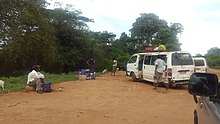
Between cities, you travel using luxury coaches like Pathfinder and Citilink . You can also get decent buses from RoadPort in Harare to other major cities including those in neighbouring countries like Johannesburg, Lusaka, Lilongwe.
Minibus taxis are available for intra-city transport, and are relatively inexpensive by European standards. They provide a cheap, though a not necessarily comfortable way of seeing the true Zimbabwe.
By taxi [ edit ]
The taxi app in Zimbabwe is called Vaya, but you will need a Zimbabwean phone number to use it. Its exchange rate is fixed at Z$1 to US$1, so you will want to pay in Zimbabwean dollars (RTGS).
The more adventurous tourists could travel by train around Zimbabwe. National Railways of Zimbabwe [dead link] runs services between most major cities at least three times per week. Many popular routes have been revived such as the Harare-Mutare route; however, stock is mostly from the post war era, so don't expect to get to your destination quickly. That said trains are very safe and (in first or business class) a comfortable and relaxing way to see much of the country. The most popular route is the daily overnight train between Bulawayo and Victoria Falls . This train passes through Hwange National Park , one of the biggest national parks in Africa, and there are plenty of opportunities to see wild animals along the route. There is a tri-weekly overnight service between Bulawayo and the capital Harare as well.
Traffic is the biggest danger because of the poor condition of cars and the driving culture. Driving after dark is not recommended, especially outside cities.
Car hijackings are possible. At traffic lights, when refuelling and otherwise when stopping your car, be alert for anyone approaching. When driving, always keep doors locked and windows closed. Be prepared for occasional fuel supply problems. Motorists should be prepared by buying an extra can of fuel.
The condition of the roads in Zimbabwe seems to have improved considerably since the stabilization of the economy. Roads between Victoria Falls and Bulawayo, Bulawayo and Masvingo (Great Zimbabwe) and Masvingo and Mutare are all in relatively good condition. The highway between Plumtree and Mutare (passing through Bulawayo and Harare in between) is being resurfaced.
Almost no fuel station in Zimbabwe takes credit cards. Also road blocks are common but usually police just want to see your driver's licence and your Temporary Import Permit (TIP). Police can fine you if you do not have reflective reflectors on your car, red hazard triangles in your boot, a spare tire, or a fire extinguisher, so be sure to carry those items if you want to avoid a fine.
By hitchhiking [ edit ]
Hitchhiking is also a viable option, but tourists need to take care with whom they accept lifts from; hijackings and robberies of hitchhikers, especially within Harare, have been on the increase in the last few years. Be sure to bring some money along, as drivers very often expect some sort of fee to be paid up front.
Talk [ edit ]
Zimbabwe has 16 official languages though in practice English, Shona and Sindebele/Ndebele are by far the most spoken. English, besides being traditionally used for official business, serves as a lingua franca between Zimbabweans of different ethnicities and will be the most useful for travelling throughout the country, though any attempts to speak the local language will greatly endear you to the locals or at the very least earn you a few laughs.
Speakers of non-native languages tend to be few and far in between and are mostly Portuguese by people with roots in Mozambique, Angola or Portugal or French largely spoken by Congolese migrants in parts of Harare and Bulawayo.
See [ edit ]
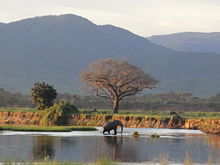
For many visitors, Zimbabwe as a country has the same appeal as the natural landscapes for which it's famous.
Urban life [ edit ]
Zim's large cities all bustle with life. The famous capital, Harare , is the one of Africa's most pleasant cities. It's a city of contrasts, there's expensive cosmopolitan boutiques, buzzing nightlife and delicious ethnic cuisine. However, it's the classic, unpolished side of the city that makes it a charming destination. The central colorful neighbourhoods where crazy traffic sounds drown out distant dance tunes, the pleasant street-cafés and garden restaurants, busy outdoor markets and historic colonial architecture. Avondale and Mount Pleasant are pleasant, older neighbourhoods of the city and a good place to indulge in the city vibe of cafés, street markets, and antique markets in a garden suburban setting. The atmosphere is perhaps Harare's biggest attraction, but some of the main sights include the National Gallery of Art and the Museum of Human Sciences.
Zimbabwe's other cities share the energetic buzz of Harare, but have a distinct character of their own. Bulawayo is a lively yet laid-back city, characterized by broad avenues and Victorian architecture. It's famous as a 'heritage city' far beyond the borders of Zimbabwe and a perfect starting point for the country's game parks to the north. In the east, Mutare , is well known for its scenic setting and is also a good base for hiking and other outdoor activities in the Eastern Highlands. The city of Gweru has shaken off its agricultural roots and is increasingly a vibrant university city. Masvingo, hosts classic Victorian architecture and serves as the gateway to exploring the Great Zimbabwe ruins
Nature [ edit ]
Sport [ edit ].
Zimbabweans love sport and are justifiably proud of their country's achievements and how they have constantly punched above their weight on the international stage. The main five sports are: Association football, Rugby Union, Cricket, tennis and Golf. All of these sports attract a widespread following, both at matches themselves and on television; and it is very common to find televised coverage of them shown in pubs, hotels and bars. There are popular grounds to all these sports around the country: Rufaro (Harare), Bourbourfields (Bulawayo), National Sports stadium (Harare) and Ascot (Gweru) for football, Harare Sports Club (Harare), Queens Sports Club (Bulawayo) and Alexandra (Harare) for cricket, Police Grounds (Harare), Old Hararians (Harare) and Hartsfield (Bulawayo) for rugby, as well as the Royal Harare Golf Club for golf.
- Football means association football or soccer. It is by far the most popular spectator sport, especially with the working class and is very widely played across the country at amateur and professional levels, with the highest competition being the Zimbabwe Premier Soccer League and the best talent moving on to play in European leagues. Dynamos (nicknamed the Glamour Boys for their dazzling 'carpet soccer' are the toast of middle class Harare), CAPS United (has a more working class fanbase) and Highlanders ( the historic Bulawayo team) are the most supported teams in the country, with a derby between either side the highlight of the season.
- Rugby is invariably rugby union has 15 players per team, and is popular with the middle classes. While the Zimbabwean national team has not been to the World Cup in two decades, they have produced countless world class players many who've gone on to glittering careers abroad. The country's highest domestic team, the Zimbabwe Academy team, plays in South Africa's Currie Cup. Old Georgians and Old Hararians are two of the countries most prestigious clubs, the latter noted for their exciting 'champagne rugby' inspired by the passing French style of play. That said the standard of play is high up to the high school level and high school games are popular and cheap weekend affairs
- Cricket is played only in the summer, and tends to be most popular in the cities. Zimbabwe is a highly competitive, if often underdog side. Visiting tours by Australia, New Zealand and South Africa are considered the highlight of the summer sporting season and are well worth a trip to one of the country's fine cricket ovals
- Zimbabwe has punched above its weight in tennis , particularly in doubles and at the Davis Cup, often the only African nation in the top tier division. Tennis is often played on hard court though grass courts are present in affluent areas like Borrowdale. Davis Cup games are the most popular and attract enthusiastic crowds. In golf , Zimbabwe forms part of the Sunshine tour with its neighbors, the third most prestigious after the PGA and European tours. The country has produced numerous golfers such as Nick Price and Mark McNulty and plenty of excellent golf courses are found in or near the larger cities
- Zimbabwe is also a respected competitor in equestrian activities, and several major events in the racing calendar are held at various venues. The most prestigious events on the horse racing calendar include the OK Grand Challenge and the Castle Tankard both held in Harare in the autumn and winter.
Do [ edit ]
- Bungee jumping at Victoria Falls. An incredible experience off the Victoria Falls bridge over the mighty Zambezi - 111 metres of pure adrenaline.
- Walk with the lions, swim with the elephants, ride a horse. and enjoy other game activities at Antelope Park near Gweru, between Harare and Bulawayo.
- An Authentic African Safari. Walking, canoeing or on a game drive in Hwange National Park or Mana Pools with African Bush Camps.
- Harare International Festival of Arts . (HIFA), every year in Harare (end of April) with some extension in Bulawayo. Music, Theater, and other shows sponsored by foreign embassies, it features top international and local artists,and also brings in town a great artcraft market.
- Diving : The only site accessible to recreational divers is Mutoroshanga Ethel Mine, a flooded asbestos quarry 120 km by road from Harare. Good visibility and beautiful surroundings. You need technical cave-diving skills to venture into Chinhoyi Caves, 120 km from Harare. The caves are mostly water-filled, and are more than 120 m deep. The full cave system has not yet been explored. No diving infrastructure, this is an expedition where you take everything.
- The excellent climate, combined with investments in the golfing infrastructure, has turned the country into a golfing haven . Fourteen of Zimbabwe's courses are rated in the top 100 best in Africa. Zimbabwe is also a great and cheap location to learn the game and perfect technique. Many resorts and clubs offer classes with rising players. Courses can satisfy the most demanding golfer, while newcomers won't be intimidated, unless they find the beautiful landscapes and stunning vistas distracting to their game. Though Zimbabwe has long punched above its weight in the golf world, the average local has mixed feelings about golf courses, namely due to the huge amounts of water required to maintain them but appreciate the revenue they generate.
- The countryside also offers a great deal of possibilities, although you will have to incite the travel guide's advice a little more than usual, as they tend to just sell safaris and trips to Victoria Falls. Cycling through the mountainous terrain of Vumba or white-water rafting in the affluents of the Zambezi is an exhilirating experience.
Buy [ edit ]
Money [ edit ].
From June 2019 to April 2024, the legal tender in Zimbabwe was the new “Zimbabwe dollar” (Z$, ISO code ZWL), also known as the "Real Time Gross Settlement (RTGS) dollar", "Zim dollar" and the "Zollar". The value of the currency was volatile. In March 2024, annual inflation was running at 55%. However, the US dollar is widely used.
On April 8, 2024, Zimbabwe introduced a new currency, named "Zimbabwe Gold" (ZiG) . Coins of the ZiG are issued in denominations of 1 ⁄ 10 , 1 ⁄ 4 , 1 ⁄ 2 , 1, 2 and 5 ZiG. Banknotes of the ZiG are issued in denominations of 1, 2, 5, 10, 20, 50, 100 and 200 ZiG. Zimbabwe dollars can be exchanged at banks for Zimbabwe Gold until 29 April 2024.
The ZiG began to fall in value soon after it was issued, and the black market rate as of 16 April was 20 ZiG = US$1.
Most retailers and service providers are trading their products in U.S. dollars or pegging their prices in Zimbabwe currency using U.S. dollar black market rates. Some retailers and public transport operators no longer accept denominations lower than the Zimbabwe dollar coin. Wikivoyage articles generally quote prices in U.S. dollars.
There are many ATMs which take Visa and MasterCard. As of at least March 2023, you will be able to withdraw money from ATMs, so bringing cash is no longer necessary. Everyone from street vendors to taxi drivers to supermarkets, restaurants, and activity operators operate in USD so there is no need to obtain Zimbabwean dollars. ATMs usually deliver crisp US$100 notes which then require changing into smaller denominations at stores and can sometimes be a challenge. Smaller USD notes are most useful and US$1 are difficult to find but the most used. Anything larger is unlikely to be accepted. If receiving change of less than US$1, you will receive Zimbabwean dollars.
Many banks do not have enough bank notes due to a shortage of paper, so will only change U.S. dollars for Ecocash. Registering for Ecocash is recommended. You will need your ID to buy an EcoNet SIM card at EcoNet shops or other small phone shops. You can then register for EcoCash, but you will need to produce your ID again to activate your account. You can then load your account at a bank, and spend money in most shops using your PIN.
A growing number of businesses accept Visa and MasterCard in Zimbabwe, however shop workers are often resistant to use them. Be careful what currency your card is charged in.
Credit cards
Credit and debit cards are used less commonly than in the United States or Europe. Many businesses in the city accept them and you can expect any major chain — supermarkets, fast food restaurants, clothing stores, etc. — to also accept them. The standard 10% tip in restaurant is often expected to be paid in cash, even when you pay the bill by credit or debit card. Bear in mind, tipping is not expected and may only apply to an establishment that does not already add a service charge.
If you use a debit or credit card, the checkout operator in places like supermarkets will often require you to present your card and a form of identification such as a drivers' licence. Present both at checkout and with confidence. A lack of confidence will lead to a request for your passport as identification.
PIN cards have become the most common and should be accepted anywhere, as well as magnetic band cards. PINs should be accepted but if not, the shop attendant will ask you to sign the invoice. Contactless credit cards are not commonly accepted as of Nov 2020.
Traveller's checks
They are rarely used and may be difficult to exchange, but some banks and exchanges may accept them . Also, Western Union will cash them with proper identification.
There is no obligation to tip in Zimbabwe although any tip is welcome, given the volatile economy. Some nicer restaurants will add a service charge (10 percent). In these cases tipping is not expected. Sometimes rounding up or telling them to "keep the change" is enough on small checks, deliveries, petrol attendants, etc. Leaving at least a 10% tip is considered kind and polite at restaurants, cafes, hotels, beauty parlors, barbers, ushers and car-washes. Tipping bartenders is not customary but will be greatly appreciated. Leaving no tip when feeling unsatisfied is not an uncommon gesture, and will not likely make much of an impression. Taxi drivers do not expect to be tipped.
Service fees are included in most upscale hotels and restaurants, usually around 10%. By law it is mandatory that this item is represented in the same text size as the rest of the menu items.
Costs [ edit ]
Domestically produced things are very cheap (especially labour-intensive things), and curios are especially well made. However, for a tourist drinking Coke and eating pizza, prices are not that much lower than in South Africa.
Eat [ edit ]

For a sample of what Zimbabweans eat (in some form, nearly every day), ask for "sadza and stew/relish." The stew part will be familiar, served over a large portion of sadza - a thick ground corn paste (vaguely like polenta and the consistency of thick mashed potatoes) that locals eat at for lunch and supper. It's inexpensive, quite tasty and very filling. There is a plethora of good Zimbabwean food- "Mbambaira" or sweet potatoes, "chibage" corn on the cob, for example. Fruits indigenous to the country like "masawu" for example. For foreigners, especially from the West, Zimbabwean meat is very tasty, especially the beef, because of animals are raised and fed on a natural diet, mostly of grass.
Food options in the cities tend to follow western conventions and British visitors in particular will find themselves right at home as numerous British staples - from pork pies, Cornish pasties and an English breakfast to tea with milk and baked beans- are a hallmark of Zimbabwean cuisine. Fast food is increasingly popular with Nando's and KFC available in most urban areas as well as local brands like Chicken Inn and Wimpy.
Specialities [ edit ]
Specialities worth sampling include peri-peri chicken , a Portuguese/Mozambican influence, meat pies (which make an excellent portable, inexpensive, and delicious snack or lunch and can be found easily at many supermarkets and bakeries.), samosas (Indian origin) bream , sadza nedovi (sadza with vegetables cooked in a peanut sauce), boerewors (spicy farmer sausages) and vetkoek (a delicious fried pastry), both South African in origin as the names suggest.
Zimbabwe has traditionally been a cattle rearing country, particularly in the south and west, and therefore features excellent (and affordable) beef. The braai is a typical Southern African barbeque that crosses all classes and ethnicities, consisting of a variety of grilled meats (steaks, beef short ribs, sausage, chuck and sometimes offal) and a peri peri or other sauce over wood fire grill. Drinks are served and it is a great way to socialise and meet new people. As in many countries with a similar meat culture, men tend to dominate the grilling, though women and children are always made to feel welcome.
Additionally, the restaurant and coffee-shop scene in Harare and Bulawayo are great by continental standards, with a wide variety of places and cuisines to choose from.
Drink [ edit ]
A variety of domestic brews are made in Zimbabwe, mainly lagers with a few milk stouts. You may even want to try "Chibuku" a local brew popular among working class men that's based on a traditional beer recipe made from sorghum and/or maize (corn). It is generally sold in a 2-litre plastic bottle called a 'skud' or a more popular variety called "Chibuku Super" that comes in a disposable 1.25 litre plastic container and costs US$1. As with all alcohol, it's definitely an acquired taste! A more palatable beer is the pilsner like, Zambezi lager which is very refreshing on a hot day.
Quality wines at restaurants and liquor stores tend to be South African or European in origin, though there are a few brands worth sampling, the standout being the Western Cape produced, Kumusha Wines , as well as the more established, Mukuyu. The South African creamy liqueur, Amarula, is a common delight. A common tradition across Southern Africa, is the Sundowner , a light aperitive style cocktail consumed at sunset just before dinner. It is usually fizzy, sparkling or citrus based, similar to a spritz in Europe
Non-alcoholic drinks
Like the UK, tea is widely drunk across Zimbabwe, especially at breakfast or during work lunch breaks. Most people drink white tea (hot black tea with milk), and some with sugar or honey. Tanganda is a cheap and common brand popular with working class residents. Finer restaurants, hotels and cafés sell a range of different teas, Earl Grey and Rooibos being popular blends, but by no means the only one. Herbal teas are available in affluent parts of town, and lemon may also be offered as an alternative to milk upon request.
Coffee is historically less popular in Zimbabwe but is growing in popularity, and best experienced at the many independent cafes in Harare, Bulawayo or touristy regions like the Eastern Highlands. Alternatively South African chains like Mugg & Bean are increasingly popular with young people.
In Zimbabwe, Mazoe orange crush (pronounced "mazo-way", roughly) is highly regarded and has near legendary status. It is a condensed orange concentrate drink of a vivid orange colour, meant to be diluted with water, and is a prized by expats and Zimbabweans alike. Whilst anywhere selling drinks in Zimbabwe is highly likely to have Mazoe, it can be increasingly found at specialty and expat stores in South Africa, Canada, Auatralia and the UK.
An acquired taste, but worth it, are Schweppes lemonade, ginger beer and cream soda (not too dissimilar to US Root beer), which are locally produced and popular summertime beverages and can be obtained in large supermarkets.
Mineral waters can vary from expensive imported brands, through locally bottled waters, which are of a high standard and much more affordable. When travelling be sure to stock up on bottled water when it is available, as clean drinking water may not be available in remote parts of the country.
Sleep [ edit ]
Zimbabwe has a great number of tourist facilities, and offers a variety of accommodation options, from luxury hotels to guest houses, lodges, backpacker hostels and safari camps for all budgets.
For nature lovers, birdwatchers, and those seeking a respite from the fast-paced world, there are many "lodges" in serene and peaceful environments, usually on the fridges of the city or near game reserves, surrounded by many species of native and migrating birds, which offer a unique opportunity to reconnect with nature.
If you are on a safari tour there are tented camps, chalets and camping sites in most of the safari areas.
Most places have a backpacker hostel with prices from US$10 a night.
Stay safe [ edit ]
Generally, Zimbabwe has a much lower crime rate than its neighbors, and Zimbabweans are well known for their unrivaled hospitality.
Most crime that does occur is opportunistic in nature and travelers should take care with their personal belongings and follow local advice. It really is just a matter of common sense, which you should exercise no matter where you are.
Shortages of fuel and water can occur in parts of the country, so keep extra supplies with you in case they are unavailable for an extended period. Water and electricity supplies are frequently disrupted, so most homes in the cities are equipped with boreholes, solar power or generators.
Whilst many locals will politely inquire about you and your country, remember, most Zimbabweans are still sensitive to foreigners' opinions of their country and its politicians, mostly due to years of negative press. In general, it is a wise idea to avoid political discussions or discussions pertaining to opinions of political leaders.
Police [ edit ]
Policing in Zimbabwe has improved markedly since the Mugabe era. On the whole, Zimbabwean police officers are professional and polite to tourists, but they are underpaid, which can lead to incidents of corruption or bribery. They are generally less aggressive than law enforcement agencies in many other nearby countries, particularly South Africa; however, this does not apply to political demonstrations or other politically motivated investigations, which have elicited very strong responses in the past. Tourists, expats and outsiders are strongly discouraged from attending political rallies or events. Bribery can occur at police checkpoints or border control but it is important to be firm and politely decline, as this behavior is not tolerated by senior authorities and harassment of tourists is considered a serious offence.
With local exceptions, such as airports, and national events, such as Independence Day parades, the vast majority of police officers in Zimbabwe do not carry firearms, and the only police officers allowed to carry firearms are those from specialist firearms units.
Most officers will only speak English, Shona or Ndebele, though they will attempt to find an interpreter for people who can't understand questioning in English. You have the legal right to silence when arrested and to have an interpreter at the police station.
Police officers in Zimbabwe usually wear dark blue uniforms, although some wear tan or khaki uniforms. Front-line police (in uniform) are also generally required to have shoulder numbers. Most police are also required to carry a warrant card, and should under reasonable circumstances be willing to produce it, to confirm their authority.
Private security guards do not generally have any "police-style" powers at all. There are a small number of non-police officials who have limited enforcement powers relating to specific local areas, or certain activities such as on-street parking or accessing some government buildings.
Road safety [ edit ]
Although jaywalking is not an offence in Zimbabwe and common in the larger cities, crossing a road other than at a designated crossing should be taken with care. A number of traffic light crossings have a push button to change the 'man' from red to green. Pedestrians have right of way on zebra crossings, that are identified by white stripes on the road and yellow flashing lights. It is advisable to make eye contact with the driver before stepping into the road. Certain roads, such as the President's residence, prohibit pedestrians (and cyclists), this is often marked with signs in clearly visible locations.
Stay healthy [ edit ]

Do your research about what is available. Take all medications that you need along with you. There are a number of private hospitals in the major cities that are very accessible.
HIV/AIDS infection rate in Zimbabwe is the 5th highest in the world at around 13% infected. Though rates have declined from their peak in the 2000s, you should never have unprotected sex . If you form a serious relationship, consider both getting an HIV test before taking things further.
Malaria is prevalent in lower regions of the country in the summertime, so unless you are going to stay entirely within Harare, Bulawayo or highland regions, anti-malarial drugs are advised. Drugs reduce the severity of the disease but don't prevent infection, so also consider precautions such as:
- sleeping under a mosquito net (lightweight travel nets are comparatively cool to use)
- using mosquito repellent on the skin or burning mosquito coils
- wearing long-sleeved clothing and long trousers, particularly in the evening
Bilharzia is present in some lakes. Ask locally before swimming.
Snakes are common in the bush, and most bites are on the foot or lower leg. If walking, particularly in long grass, wear proper boots and either long, loose trousers or thick, concertinaed hiking socks. Shake out boots and shoes in the morning, in case you have a guest. These precautions also reduce the chance of scorpion sting. If you do get bitten or stung, stay calm . Try to identify the exact culprit, but get to medical assistance as rapidly as you can without undue exertion. Many bites and stings can be dangerous, so it is safer to seek treatment, which is very effective these days.
Tap water , as a source of potable water, in general, should be boiled prior to consumption. Bottled water is also available.
Respect [ edit ]
Visitors to Zimbabwe will find Zimbabweans incredibly welcoming, friendly, and hospitable. Many will go out of their way to help you and ensure you have a good time. You can freely approach the locals for advice and you can ask them specific directions to get somewhere.
As is the case throughout Africa , respect for elders is very important and it is customary to use honorifics with people you're not well acquainted with. Try not to ignore, contradict, or publicly disagree with someone older than you or in a position of authority.
In smaller towns and villages, especially on the road, if you walk past somebody it is customary to exchange pleasantries. They may also ask you "how are you", or another similar variation, is usually standard. A simple hello or "how are you?" or "have a nice day" will suffice. Learning similar phrases in Shona or Ndebele will go a long way with older and more rural inhabitants as well.
Unlike many other African nations, Zimbabweans tend to be punctual and on time to events, especially for business, however, given the importance of public transportation, it's not uncommon to sometimes be a few minutes late to something. A simple apology or acknowledgement of one's tardiness is generally acceptable however, extreme lateness is considered rude and a waste of the other parties' time.
Zimbabwe is a multicultural country. Do not make assumptions based on ethnicity or peoples' appearance. Outward displays of racism, discrimination or sexism, will be met with hostility or even land you in trouble with the law. Surprised comments at the presence of white or Asian Zimbabweans will be seen as incredibly ignorant.
Zimbabwean people are generally easy going and have a live and let live attitude and will respect your privacy and personal space . That said it is important to greet and acknowledge others when entering a space.
When shaking hands or handing anything valuable to someone in more rural areas, it is polite to support the right forearm with the left hand (or vice versa), to signify the "weight" of the gift or honour. In practice this often means just touching the forearm, or even gesturing towards it. Outsiders are generally not expected to know local etiquette, a firm polite handshake is good enough, though attempts at such will be well appreciated
Discussions about politics are generally avoided by locals . Opinions between individuals vary significantly, and while few Zimbabweans miss the volatility of the past few decades, few will voluntarily offer their opinions publicly and visitors are advised to do the same. Most Zimbabwean people of moderate views have grown accustomed to simply avoiding the topic in polite conversation, especially as speaking out against the government could attract harassment by the police and supporters of the government.
- Has custom banner
- Has map markers
- Articles with dead external links
- Outline countries
- Outline articles
- Country articles
- Has Geo parameter
- Southern Africa
- All destination articles
- Pages with maps
Navigation menu

Top 10 Tourist Attractions in Zimbabwe

Zimbabwe is a country endowed with so much natural beauty, profound history, vast and remarkable landscapes, and an incredible diversity of wildlife, birdlife, national parks, and reserves to explore. Zimbabwe boasts a range of diverse habitats, from the forested valleys of Matobo Hills National Park, and the watery wilderness of Lake Kariba, to the floodplains of Mana Pools National Park, and the mopane woodlands and savannas of Hwange National Park.

Beyond its astounding landscapes and habitats, Zimbabwe is home to an astounding 500 species of birds, 199 mammal species, 130 species of fish and several rare and endemic species such as the sable antelope.

What sets Zimbabwe apart from its fellow southern African neighbors is the fact that it offers tourists and travelers alike the chance to experience superb game viewing and unforgettable safari adventures without the large crowds – Undoubtedly making it one of the best safari destinations to visit in Africa.
Offering an endless variety of things to see and experience, here are the best things to do and top 10 tourist attractions in Zimbabwe, all of which should be on your Zimbabwean bucket-list.
#1 Hwange National Park

Hwange National Park is one of Africa’s top national parks. Covering a vast expanse of around 5,655 square miles/14,650 square kilometers, it is both the largest and oldest of Zimbabwe’s game reserves.
Hwange National Park is undoubtedly one of the top tourist attractions for wildlife enthusiasts as the park has the biggest diversity of mammals out of the world’s national parks. Home to over 100 species of mammals, including the renowned African Big 5, lion, elephant, leopard, rhino, and buffalo, Hwange National Park’s game viewing and sightings are unparalleled. In addition to its exceptional diversity of wildlife, this world-renowned national park is famous for its profound population of elephants, boasting over 50 000 elephants. The Hwange elephant population is thought to be one of the largest in the world.
The park is also known for regular sightings of some of Africa’s rarest safari animals, such as the brown hyena, the critically endangered black rhino, roan, sable, and the endangered wild dog – Hwange National Park is said to be home to one of Africa’s largest populations of the endangered wild dog. Visiting Hwange during the dry winter months of July to October guarantees spectacular wildlife sightings, as animals gather around the man-made waterholes in the park to drink. Birdlife is also abundant at Hwange National Park, with over 500 species recorded within the park.
What makes Hwange so special is the fact that it is easily accessible as well as its lack of crowds. For all of its biodiversity, huge herds of elephants and ease of sightings in the winter months, the park never gets crowded, which means you have the space and the quiet to soak up the magic of the bush.
#2 Lake Kariba

Situated in the north of Zimbabwe, northeast of Victoria Falls and sharing a border with Zambia, Lake Kariba is landlocked Zimbabwe’s answer to the seaside: a massive manmade lake that provides a wonderful combination of water and wildlife. Stretching for over 140 miles/220 kilometers in length, and measures 25 miles/40 kilometers across at its widest point, it is the world’s largest man-made lake in terms of volume. The traditional and by far the best way to explore the wonders of Lake Kariba is on a houseboat. Kariba is renowned as one of the best places in the world to catch tiger fish, a ferocious freshwater species, as well as for its remarkable sightings of hippos, crocodiles, elephants and vast birdlife.

The lake’s islands also offer ample opportunities for game viewing. Perhaps the most rewarding wildlife area is Matusadona National Park, located on Kariba’s southern shore.
#3 Mana Pools National Park

Photo credit: flickr
Regarded as being both Zimbabwe’s best park and one of the finest wilderness areas in Africa, Mana Pools National Park is a superb safari destination. Situated at the northern most point of Zimbabwe straddling the Zambian border, Mana Pools is renowned for its untamed natural beauty: a riverine wilderness on the Zambezi River of pools, floodplains, baobab trees and forests that feels totally remote and never gets crowded.

Recognized as a UNESCO World Heritage Site for its incredible and diverse concentration of wildlife, Mana Pools National Park is undoubtedly one of the top tourist attractions in Zimbabwe for wildlife lovers from around the world. The park is famous for its huge elephant herds, as well as exceptional sightings of cheetahs and the entire African Big 5. It is also known as one of the top places in Africa to spot the endangered African wild dog.

Mana Pools is a haven for water-based wildlife, with large populations of hippo and Nile crocodile. They live in the four pools that give the park its name, each one created by the Zambezi River before it altered its course to flow northward. The largest pool is approximately 3.7 miles/6 kilometers long, and acts as a valuable water source, especially in the height of the dry season. The abundance of water present in this area makes it a prime spot for birders.

The appeal of the park is not just its wildlife – it’s how you get to experience the bush in immersive ways: staying in unfenced campsites in the midst of the wilderness and going on walking and canoeing safaris to see its profound and diverse wildlife and birdlife is where the true magic and adventure lies. Mana Pools National Park is also one of the only parks in Africa where you can walk and explore without a guide. It is however advised that you have a lot of bush knowledge and experience before going off on your own.
#4 Victoria Falls

Tumbling down 100-metre-high cliffs surrounded by lush forests, Victoria Falls is the biggest sheet of falling water on the planet. Regarded as one of Africa’s most astounding sights as well as one of the Seven Wonders of the Natural World, Victoria Falls reigns supreme as one of Zimbabwe’s top tourist attractions.

During peak flood season (February – March), the spray thrown up by the plunging Victoria Falls water can be seen from approximately 50 kilometers away. This spectacular natural spectacle which has people travelling from around the world to witness and experience first-hand, gives the falls its indigenous name — Mosi-oa-Tunya , or “The Smoke That Thunders”.

Stretching 1.7 kilometers wide, the falls span across both Zimbabwe and Zambia. There are pathways on each side of the border that lead you to the edge of cliffs. On the Zimbabwean side, the path winds its way along the edge of the gorge with viewpoints offering breathtaking panoramas of the plummeting water and the renowned rainbows that hang suspended above the chasm. While the sound is known to be somewhat overwhelming, and you’re bound to get soaking wet from the famous falls’ spray (a bucket-list worthy experience in itself), the magnificent spectacle you get to witness is one you’ll never forget.
As the town of Victoria Falls sits right by the falls themselves on the Zimbabwean side, it is famous for its vast variety of thrilling adrenaline sports and incredible safari activities. Some of these experiences include bungee jumping, abseiling, white-water rafting, and wildlife spotting from horseback.
#5 Matobo National Park

Regarded as the spiritual home of Zimbabwe, Matobo National Park boasts some of the world’s most impressive granite scenery. The fascinating granite rock formations and lunar landscape of balancing rocks, known as kopjes – giant boulders stacked on top of each other, as if they’re about to topple over – is not only a remarkable sight and one of the top tourist attractions in Zimbabwe, but a stunning natural spectacle and work of art. This site has an intriguing history, tracing back some 2000 million years ago when molten rock erupted across the landscape.
Several of the rocks are marked with ancient rock art created by the San bushmen about 2000 years ago. In fact, the recreational section of Matobo National Park has Southern Africa’s highest concentration of ancient rock art with 3500 sites dating back 13,000 years. To this day the Matobo Hills are considered incredibly important to the local community as they are used as sacred sanctuaries and shrines.

Matobo National Park is an exceptional wildlife and safari destination. The game park section of Matobo National Park is not only home to Zimbabwe’s highest concentration of white and black rhinos, it has one of the largest leopard populations in Southern Africa and is a great place to spot Verreaux’s eagles, in addition to other wildlife and birdlife species.
**Interesting Fact: Cecil Rhodes, a controversial 19th-century imperialist, businessman, and politician, was buried here. His remains are marked by a brass plaque perched atop World’s View, the park’s most iconic viewpoint.
#6 Chimanimani National Park

Located on the eastern border with Mozambique, the mountainous Chimanimani National Park is known for its unapologetic natural beauty. Famous for its plunging gorges, lush valleys, mountain landscapes, and soaring peaks, with the highest summits reaching over 7,990 feet/2,400 meters, Chimanimani National Park has become a top destination among adventure seekers, keen hikers, campers, and those looking to immerse themselves in nature.

If you’re a wildlife enthusiast, you certainly won’t be disappointed when visiting this top Zimbabwe tourist attraction and natural oasis. As the lower reaches of the park are covered by dense virgin forest, it is known to attract and provide shelter to several obscure wildlife species including eland, sable, and the blue duiker antelope. It is also one of the best parks in Zimbabwe to spot the elusive leopard as they roam free in the Chimanimani mountains, as well as enjoy incredible sightings of Southern Africa’s smaller cat species such as Serval, the African Wildcat, Caracal, the mysterious Sand Cat, Jungle Cat, Black-Footed Cat, and the African Golden Cat. If you’re an avid birder, you can look forward to some spectacular birdlife sightings when visiting Chimanimani National Park and the Chimanimani mountains.

Amenities in the park include unpaved hiking trails, communal huts and a campsite with basic cooking and ablution facilities. Wild camping is also allowed throughout the park.
#7 Nyanga National Park

Regarded as the home of the Highveld, Nyanga National Park is a wild and wonderful place to visit on any trip to Zimbabwe. Located more than 1,800 meters above sea level, it is said to be perched on the very roof of Zimbabwe, formed by hulking hills of dolomite rock and suspended boulders – Making it quite a unique sight to behold.
Besides being the home of the Zimbabwean Highveld, Nyanga National Park boasts a fascinating and incredible landscape which is dressed in groves of msasa trees and cypresses which are considerably rare to these regions. Due to the vastly unique landscapes of the park, the unique habitats that exist within Nyanga National Park can host a truly otherworldly array of creatures and a remarkable diversity of wildlife species.

Several of the species in the park are entirely endemic to the region, such as the Old World Samango monkeys with their white-brushed throats that can only be found in these parts of the world. The Nyanga National Park is also home to a number of leopards, lions, and other wildlife species, ensuring you get to enjoy the full authentic African safari and wildlife experience.
#8 Chinhoyi Caves

Located in north central Zimbabwe, the mysterious Chinhoyi Caves is not only one of the top tourist attractions in Zimbabwe, but a place of geological interest too. Made up of a subterranean system of limestone and dolomite caverns and tunnels, the caves are protected as part of the Chinhoyi Caves National Park. The caves have a mystical appeal about them as local elders believe they are sacred. Due to several artifacts found and uncovered in the caves (such as pottery, drawings, and human remains), it is suggested that the caves have been inhabited since at least the 1st century. Most famously, the Chinhoyi Caves provided a refuge from raiding tribes for Mashona chief Chinhoyi and his people.
Undoubtedly the main attraction of the Chinhoyi Caves is the ‘Wonder Hole’. This deep blue natural pool is a collapsed cavern with sheer walls that drops straight down into what is known as the crystalline Sleeping Pool. Besides a bucket-list worthy experience, the glacial blue color of the lake’s water provides the perfect backdrop for the most incredible photographs. It is also the site where visitors can enter the illuminated Dark Cave.
A visit to Chinhoyi Caves is a great opportunity to hear and learn about the historical significance of the caves as well as the folklore that surrounds this mysterious place. Chinhoyi is a popular destination for technical scuba divers.
#9 The Great Zimbabwe National Monument & Masvingo

A UNESCO World Heritage Site, the Great Zimbabwe National Monument is located approximately a four-hour drive south of Harare or east of Bulawayo (two of Zimbabwe’s largest towns). Regarded as one of Zimbabwe’s top tourist attractions, the Great Zimbabwe National Monument protects the remains of Great Zimbabwe, the capital of the historic Kingdom of Zimbabwe and the most important stone ruins south of the Sahara. Built between the 11th and 15th centuries, these 700-year-old ruins crumble and crack under the sun, revealing tales of grave history and the nation’s old Shona-speaking folk.

The ruins cover a vast area, including a hilltop acropolis which once housed kings and chiefs. Making it quite an enthralling historical landmark to visit and explore on your trip to Zimbabwe. The valley surrounding the Great Zimbabwe National Monument is scattered with the ruins of more humble dwellings, all of which were built using perfectly cut granite blocks. As various artifacts such as porcelain from China and Arab coins from the East African coast have been discovered at this very site, it suggests that Great Zimbabwe was once a powerful and wealthy center of trade.
Some 20 kilometers away from the UNESCO World Heritage Site of Great Zimbabwe is where you’ll find Masvingo. Situated neatly on the edge of the Mutirikwi National Park, Masvingo is the ultimate destination for keen adventure travelers and thrill seekers looking to explore and discover as it has plenty in the way of outdoor exploration up its sleeve. It is also regarded as one of the prime drop off points, welcoming VIP tourists and travelers to the deeper reaches of Zimbabwe, as they make their way through to the southern edge of the country.
#10 Matusadona National Park

A relic of the former state of Rhodesia, Matusadona National Park clings to the southern banks of Lake Kariba, on the Zimbabwean side of the great water body. After becoming subsumed by Zimbabwe following the various upheavals, the area retained its protected status and established itself as one of the top tourist attractions in Zimbabwe.

One of Matusadona National Park’s main allures is that the whole region is beautifully untouched and untrodden. This makes it the perfect African wilderness escape for those seeking an off-the-beaten-track safari adventure. In addition to its vast diversity of wildlife, the majestic Cape buffalo and African elephant are by far the two most popular wildlife species you can look forward to seeing when visiting Matusadona National Park.

The nearby water of Kariba provides ample grazing lands which has only flourished since the creation of the Kariba Dam. This allows ungulates such as giraffes, hippos, rhinos, zebras, wildebeest, aardvark, and an incredible array of antelope (to mention merely a few), and predators alike to thrive along its fringes.

Kariba is also known as one of the best places in the world to catch tiger fish, as well as for its remarkable sightings of hippos, crocodiles, and vast birdlife. The lake’s islands offer ample opportunities for game viewing with the most rewarding wildlife area being none other than Matusadona National Park.
Contact Secret Africa
+27 21 204 6073
Email: [email protected]
Address: Workshop17, 17 Dock Road, V&A Waterfront, Cape Town, 8005
Important Pages
- Privacy Policy
- Terms & Conditions
- Newsletter Sign Up

This site uses cookies. By continuing to browse the site, you are agreeing to our use of cookies.
Cookie and Privacy Settings
We may request cookies to be set on your device. We use cookies to let us know when you visit our websites, how you interact with us, to enrich your user experience, and to customize your relationship with our website.
Click on the different category headings to find out more. You can also change some of your preferences. Note that blocking some types of cookies may impact your experience on our websites and the services we are able to offer.
These cookies are strictly necessary to provide you with services available through our website and to use some of its features.
Because these cookies are strictly necessary to deliver the website, you cannot refuse them without impacting how our site functions. You can block or delete them by changing your browser settings and force blocking all cookies on this website.
These cookies collect information that is used either in aggregate form to help us understand how our website is being used or how effective our marketing campaigns are, or to help us customize our website and application for you in order to enhance your experience.
If you do not want that we track your visist to our site you can disable tracking in your browser here: Click to enable/disable Google Analytics tracking.
We also use different external services like Google Webfonts, Google Maps and external Video providers. Since these providers may collect personal data like your IP address we allow you to block them here. Please be aware that this might heavily reduce the functionality and appearance of our site. Changes will take effect once you reload the page.
Google Webfont Settings: Click to enable/disable Google Webfonts.
Google Map Settings: Click to enable/disable Google Maps.
Vimeo and Youtube video embeds: Click to enable/disable video embeds.
You can read about our cookies and privacy settings in detail on our Privacy Policy Page.

See More Stories Like This


Zimbabwe Travel Guide
Our Latest Stories
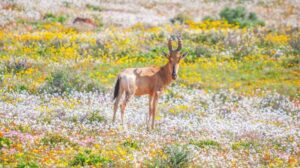
South Africa’s national parks just got bigger
South Africa’s national parks just got bigger, thanks to the National Parks Trust of South Africa (NPTSA) and World Wide Fund for Nature (WWF) South Africa.
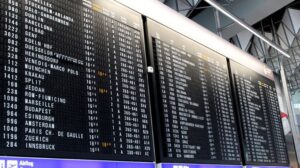
Travel & Tourism to break records in 2024 – WTTC
The World Travel & Tourism Council (WTTC) forecasts a record-setting year for Travel & Tourism in 2024, with the sector’s global economic contribution expected to hit $11.1 trillion.

Top Restaurants in Harare in 2024
Harare, the vibrant capital of Zimbabwe, is a city that boasts an eclectic mix of cultures, which is vividly reflected in its culinary landscape.
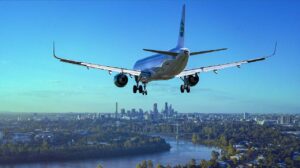
Global Air Travel Surges: Strong Recovery Hits 99% of 2019 Levels
The International Air Transport Association (IATA) shared data on November 2023 air travel, revealing that demand has reached 99% of 2019 levels.
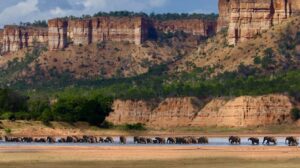
Gonarezhou National Park: A Wildlife Wonderland in Zimbabwe
Gonarezhou National Park is Zimbabwe’s second-largest national park, covering over 5,000 square kilometers of pristine wilderness.
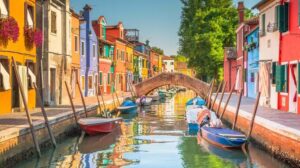
Venice to Cap Tour Group Sizes
The Italian city of Venice will limit the number of travelers allowed on tour groups in the latest effort to minimize over-tourism in the historic canal city.
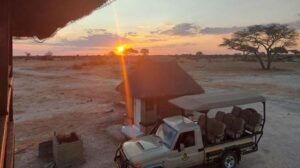
Hwange National Park | Zimbabwe’s Wildlife Haven
Hwange National Park stands as an expansive canvas of untouched wilderness, spanning an impressive 14 650 square kilometers.

Jameson Connects Zimbabwe Debuts in Harare on November 4
Jameson Connects Zimbabwe is set to make its debut in Harare on November 4, 2023, at Jam Tree Restaurant.

The National Gallery of Zimbabwe: A Journey Through Art and History
The National Gallery of Zimbabwe stands as a testament to the nation’s rich artistic heritage and its enduring commitment to creativity.
Zimbabwe Travel Guide | Discover the Magic of Africa
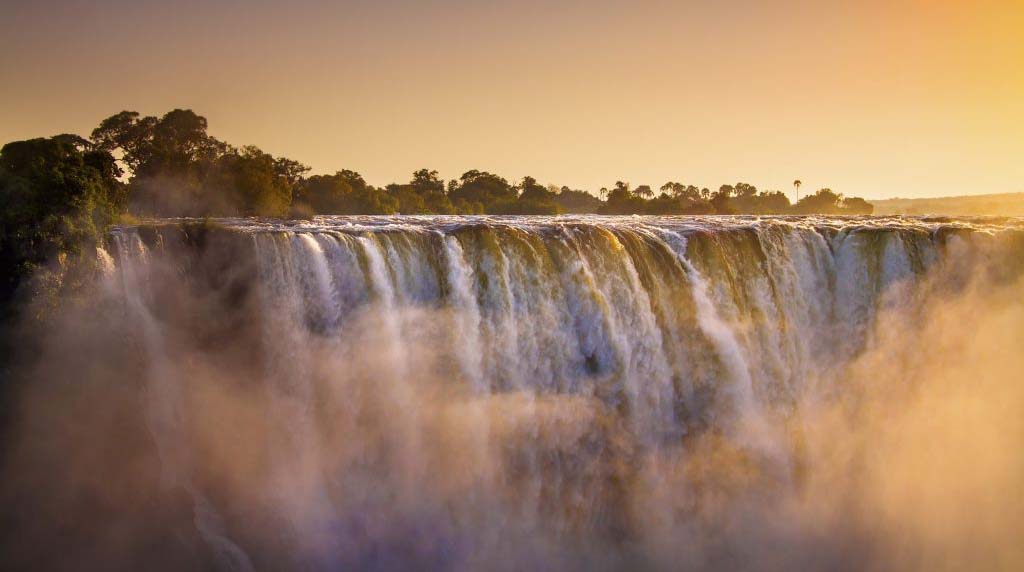
If you’re looking for an African destination that boasts natural wonders, diverse wildlife, rich cultural heritage, and friendly people, then Zimbabwe is the perfect place for you. At Zimbabwe Travel Guide, we aim to be your ultimate resource for all things related to traveling and touring Zimbabwe.
Uncovering the Hidden Gems of Zimbabwe
Zimbabwe is a landlocked country located in Southern Africa that has been often overlooked by tourists, but is quickly gaining popularity as a must-see destination.
From the majestic Victoria Falls , one of the Seven Natural Wonders of the World, to the impressive wildlife reserves of Hwange National Park and Mana Pools National Park, Zimbabwe is a hidden gem that offers a unique and authentic African experience.
Expert Travel Advice and Tips
At Zimbabwe Travel Guide, we take pride in our in-depth knowledge of Zimbabwe’s tourism industry.
Our team of experienced writers and travel experts work tirelessly to provide our readers with up-to-date and accurate information on everything from historical and cultural landmarks to adventure activities and safari tours.
Our website is designed to be user-friendly, with detailed descriptions and high-quality images of Zimbabwe’s tourist destinations.
We want our readers to get a sense of the beauty and diversity of this country, and be inspired to visit it themselves.
Travel Planning Made Easy
We believe that every visitor to Zimbabwe deserves a unique and memorable experience, which is why we provide all the information you need to plan your trip.
Our blog covers accommodation options, travel guides, things to do, events, local attractions , visa requirements, travel insurance, and recommended vaccinations.
With our extensive knowledge of Zimbabwe’s attractions and our dedication to providing quality travel information, we aim to make your visit to Zimbabwe unforgettable.
Join Us on an Exciting Journey
Zimbabwe Travel Guide is your go-to source for everything related to Zimbabwe.
Whether you’re a first-time visitor or a seasoned traveler, we guarantee that our blog will provide you with the best of the best when it comes to Zimbabwe’s travel information.
So, join us on this exciting journey and discover the magic of Zimbabwe for yourself!

Copyright © 2022 Zim Travel Guide. All rights reserved.
- +263 719 534 199
- [email protected]

Tourism in Zimbabwe
Zimbabwe, also named the ‘world of wonders,’ is one of the world’s leading destinations. Zimbabwe’s tourism sector is a perfect choice when contemplating Zimbabwe’s investment because of its countless natural and cultural wonders and favorable environment all year round. It is maybe the most exciting sector in Zimbabwe since it is the fastest-growing sector that provides GDP to the countries, and it is ever rising by 6.1%. The tourism industry in Zimbabwe hires over 90,000 workers and presents various business opportunities.
A general overview
Zimbabwe’s Tourism Authority (ZTA) figures indicate that the number of visitors arriving in Zimbabwe declined 11% in 2019 from 2.29 million in 2018, attributed to destination photos’ political unrest following elections in August 2018 and to the stay-off demonstrations in January 2019. Most tourists have come from Africa and the Middle East, while the number of arrivals from Europe, the Americas, Oceania, and Asia has decreased. The ZTA reported that the extreme macro and rapid inflation conditions led to the decline in hotel occupancy rates for the world over the same period. Due to the detrimental consequences of the COVID-19 pandemic and the reduction in foreign tourism, the scenario will further deteriorate in 2020.
Leading Sub-Sectors
In recent years, the government funded investment in capital in the tourism sector by providing tax benefits and duty-free import status in some capital categories to the hotel, restaurant, and safari operators. Wildlife photography and hunting tourism often offer tremendous growth opportunities. Still, some conservations had trouble securing trophy hunting permits from the government when citizens wanted to gain the property’s advantage for indigenization through political maneuvers. The U.S. act also forbids the introduction into the United States of elephant trophies.
Opportunities
In Victoria Falls, comparatively limited real estate rates provide possibilities for constructing hotels and lodges. The region could also be helped by the designation of Victoria Falls as a special economic zone for tourists and an International Financial Centre. The government also widened the runway to handle any form of jumbo jets at Victoria Falls airport to build a new terminal for passengers. This means the infrastructure (road, train, water, telecommunications, and energy) is redundant and rehabilitated. As the world transitions to sustainable tourism, expert preparation, and direct investment in eco-travel and adventure travel companies are available. The Zimbabwe investment authority also recognizes prospects for constructing meetings and exhibition centers, resorts and casinos, and shopping malls. Zimbabwe investment authority ZIA Many in Zimbabwe cater to lavish tourist lodges, but the possibilities to create locations in the medium-sized sector would improve as tourists’ number rises.
Previous Post LE « GLOBAL TOURISM FORUM » EN COURS DE ROUTE AU GABON !
Next post tourism in germany, you may also like.

Open letter from Secretary General on current crisis and its solutions
Uzbekistan and Kazakhstan finalizing negotiations on launching Silk Road Visa

WTFI is registered with the number of UK00003455032 by Intellectual Property Office of United Kingdom
Privacy Policy & Terms of Service @ 2022 World Tourism Forum Institute
Developed by Hypno Digital

FEATURED CONTENT
WTFI Town Halls
HATT Business School
Zimbabwe Travel Guide: Essential Facts and Information
Get tips on top attractions, safaris, visas, vaccinations, and more
:max_bytes(150000):strip_icc():format(webp)/DSC00412-5b73daf7c9e77c0057ca2198.jpg)
Zimbabwe is a beautiful African country, rich in resources and hardworking people. Despite political turmoil, it is a rewarding travel destination . Much of Zimbabwe's tourism industry revolves around its incredible natural beauty. It is a country of superlatives, thanks to Victoria Falls (the largest waterfall in the world) and Lake Kariba (the largest man-made lake in terms of volume). National parks such as Hwange and Mana Pools teem with wildlife, making Zimbabwe one of the continent's best places to go on safari .
Fast Facts About Zimbabwe
- Location and size : Zimbabwe is a landlocked country in southern Africa. It is bordered by South Africa to the south, Mozambique to the east, Botswana to the west, and Zambia to the northwest. Zimbabwe has a total area of 150,872 square miles (390,757 square kilometers), making it comparable in size to the U.S. state of Montana.
- Capital : Harare
- Demographics : The country's population is approximately 16 million people. The average life expectancy is approximately 58 years.
- Languages : Zimbabwe has no fewer than 16 official languages (the most of any country). Amongst these, Shona and Ndebele are the most widely spoken, in that order.
- Religion : Christianity is the predominant religion in Zimbabwe, with Protestant Christians accounting for 85 percent of the population.
- Currency : The U.S. dollar was introduced as the official currency of Zimbabwe in 2009 in response to the hyperinflation of the Zimbabwean dollar. Although several other currencies (including the South African rand and the British pound) are considered legal tender, the U.S. dollar is still the most widely used.
- Weather : In Zimbabwe, the summer months (November through March) are the hottest and the wettest. The annual rains arrive earlier and leave later in the northern part of the country, whereas the south is generally drier. Winter months (June through September) see warm daytime temperatures and cool nights. The weather is generally dry during this time.
- Best time to visit : Generally, the best time to visit Zimbabwe is during the dry season (April through October), when the weather is at its most pleasant. The lack of available water this time of year forces animals to congregate around rivers, lakes, and waterholes, making them easier to spot whilst on safari.
Key Attractions in Zimbabwe
- Victoria Falls : Known locally as "The Smoke That Thunders," Victoria Falls is one of the most impressive natural sights on the African continent. Located on the border between Zimbabwe and Zambia, it is the world's largest waterfall. There are walkways and viewpoints on the Zimbabwean side, whereas adrenalin-fuelled activities such as bungee jumping and whitewater rafting abound on the Zambezi River.
- Great Zimbabwe : The medieval capital of the Kingdom of Zimbabwe during the late Iron Age, this ruined city of Great Zimbabwe is now one of the most important archaeological sites in sub-Saharan Africa. It is recognized as a UNESCO World Heritage Site and comprises three connected complexes full of ruined towers, turrets, and walls all magnificently engineered and constructed from stone.
- Hwange National Park : Located in western Zimbabwe, Hwange National Park is the largest and oldest game reserve in the country. It is home to the Big Five and is especially famous for its huge herds of elephant and buffalo. Hwange is also a haven for several rare or endangered species, including the South African cheetah , the brown hyena, and the African wild dog.
- Lake Kariba : On the border between Zambia and Zimbabwe lies Lake Kariba, the largest man-made lake in the world. It was created in 1958 by the damming of the Zambezi River and supports an incredible variety of bird and animal life. It is famous for houseboat vacations and for its population of tigerfish (one of the most sought-after game fish in Africa).
Getting to Zimbabwe
Robert Gabriel Mugabe International Airport (formerly Harare International Airport) is the main gateway to Zimbabwe and the first port of call for most visitors. It is serviced by several international airlines, including British Airways, South African Airways, and Emirates. Upon arrival in Harare, you can catch a domestic flight to several other areas of the country, including Victoria Falls and Bulawayo, Zimbabwe's second-largest city.
Visitors to Zimbabwe will need to check whether they need to apply for a visa in advance. Visitors from the United States, United Kingdom, Australia, New Zealand, and Canada all require a visa, which can be purchased at the port of entry. Note that visa rules change frequently, so wherever you're from, it's a good idea to double-check the latest regulations with your nearest embassy.
Medical Precautions for Visiting Zimbabwe
Several vaccinations are recommended for safe travel to Zimbabwe. In addition to regular vaccines, hepatitis A and B, typhoid, cholera, yellow fever, rabies, and influenza vaccines are all strongly advised. Malaria is a problem in Zimbabwe, so you will need to bring prophylactics. Ask your doctor which ones are best for you. For a full list of medical requirements, check the Centers for Disease Control and Prevention website.
The 10 Best Places to Visit in Zimbabwe
Hwange National Park: The Complete Guide
Lake Kariba, Zimbabwe: The Complete Guide
Mana Pools National Park: The Complete Guide
A Guide to Southern Africa's Four Corners Region
The 10 Most Beautiful Waterfalls in Africa
Victoria Falls, Zimbabwe and Zambia: The Complete Guide
The Best Places to Go in Southern Africa
Africa Highlights: What to Do and Where to Go
Kenya Travel Guide: Essential Facts and Information
22 Fun Facts About Africa
The Top 12 National Parks to Visit in Africa
The Best Time to Go on Safari
Top 10 Destinations in Africa for a First-Time Visitor
Ghana Travel Guide: Essential Facts and Information
Gabon Travel Guide: Essential Facts and Information

TRAVEL LOCAL
Welcome to #ZimBho! A celebration of the goodness of our rich and diverse tourism offering, embracing the beauty of our Zimbabwe, iZimYami! Indulge yourself in that travel adventure, a quiet getaway, or a fun business trip, or that luxurious vacation and even that budget road trip! It’s #ZimBho, there is something for everyone! And you don’t always have to be away for long on vacation, it can just be a day trip, all you you’ve got to do is #vakatsha!
Our short story “ZimBho” is motivated by the street lingo “Bho”, a slang word casually used in everyday language, meaning “good” or showing common understanding. Celebrating the different offerings in our tourism together makes us as Zimbabweans have that common agreement that because of its rich and diverse tourism offerings Zimbabwe is “Bho”, #ZimBho. and should be explored i.e. #vakatsha. “Bho” has evolved from just being “Bho” to “Bho zvekuti” meaning very good, and the latest being “Bholato” which again is a slang way of saying very good. ZimBho also resonates with one saying I am Zimbabwean – I am Zimbo – I am ZimBho, we connect with our motherland in a special way and we pride in it, #iZimYami! And we will explore #vakatsha!
Domestic Tourism Campaign
The Ministry of Tourism and Hospitality (MoTHI) through the destination promotion agency, the Zimbabwe Tourism Industry Authority (ZTA) launched the Domestic Tourism Campaign. This campaign aims to promote local tourism and inculcate a culture of travel amongst locals. It is important to note that Zimbabwe has a wide range of attractions and activities which appeal to the both the domestic and international market. As part of efforts to boost domestic tourism, it is therefore vital for locals and the Diaspora to consider Zimbabwe as a destination of choice. Rich in history and heritage, beautiful landscape wildlife and other products, there is huge potential for the different domestic market segments including families, couples, friends and relatives and churches to partake and enjoy Zimbabwe’s tourism product offerings. Enjoyment could come in various forms including taking daily excursions visiting various attractions, participating in different tourism activities, eating out, enjoying local cuisine, participating in relaxation and recreation activities, visiting friends and relatives in different parts of the country, and spending at least one night at different accommodation facilities in different parts of the country, resorts and park estates.
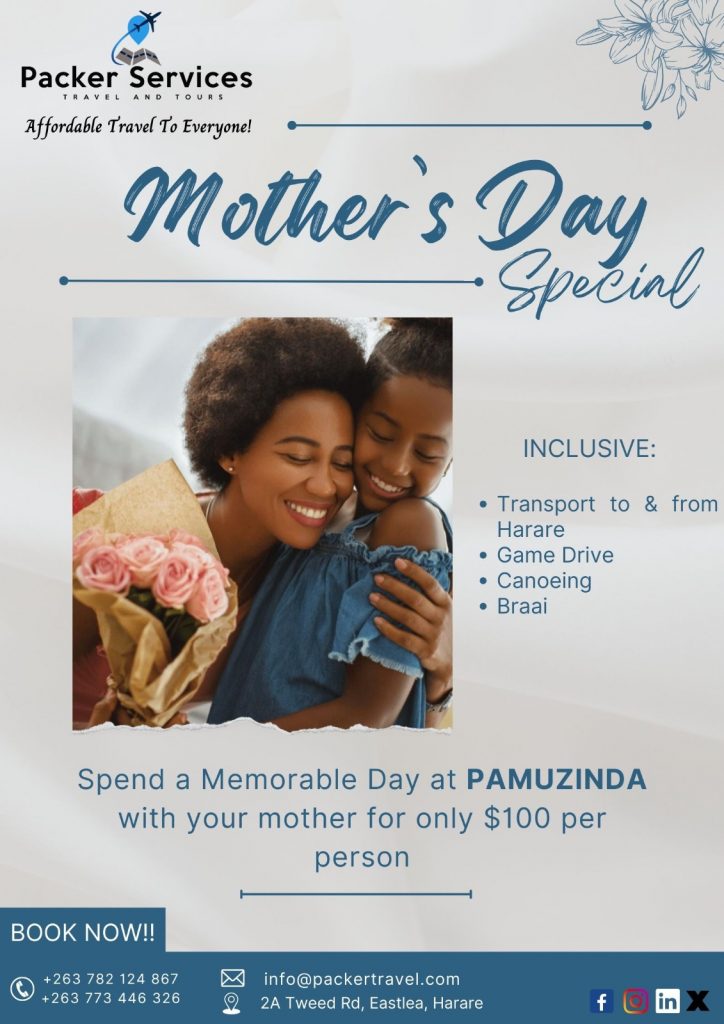
UN Tourism | Bringing the world closer
Share this content.
- Share this article on facebook
- Share this article on twitter
- Share this article on linkedin
First national Tourism Satellite Account Launched in Zimbabwe
- 31 Mar 2022
UNWTO has partnered with the Ministry of Environment, Climate, Tourism and Hospitality Industry (MECTHI) of Zimbabwe to launch the country’s first National Tourism Satellite Account (TSA) today.

The Account shows the size and significance of the tourism sector for the Zimbabwean economy, based on the last available pre-COVID-19 data and on data gathered before the formal transition of national currency from US dollar into the Zimbabwean Dollar. The TSA revealed that tourism accounted for 4.25% of the National Gross Domestic Product (GDP) with a value of USD1.03 billion in 2018. In 2019 the sector accounted for 6.3% of GDP with a value of USD1.23 billion. At the same time, the data also shows that tourism accounted for 1.56% of national employment levels in 2018, with around 100 000 jobs supported and created.
The TSA was produced as part of the Zimbabwe Destination Development Program , a technical assistance program supported by International Finance Corporation (IFC). As well as recording the number of tourists visiting the country, the initiative also provides monetary and non-monetary tourism data related to demand and supply and measures the value of expenditure on goods and services across all types of tourism as well as the value of tourism-sector industries producing goods and/or services. It will be used for quantifying tourism’s contribution to GDP and national employment rates.
Data for tourism’s restart and recovery
Tourism in Zimbabwe has been significantly impacted by the pandemic, with the introduction of travel restrictions and lower demand from tourists leading to a massive fall in visitors. The loss to the national economy is estimated at USD690m. According to the IFC’s Country Manager, Adamou Labara said, ‘these empirical findings highlight the opportunity for policymakers in Zimbabwe to support recovery of the tourism sector through stimulating traveller demand, and responsibly reducing barriers to entry’.
By addressing information gaps and supporting a data-driven approach to policy development and investment decisions , the TSA should prove particularly relevant to Zimbabwe’s tourism sector as it works towards sustainable recovery and growth from the impacts of the pandemic. The development of the TSA is one of the key milestone projects for the tourism sector under the National Development Strategy (NDS1 2021-2025).
Contact: [email protected] Cheryl Khuphe; [email protected]
Related links:
- Download the news release in PDF
- Tourism Statistics Data
- Tourism Enjoys Strong Start to 2022 while Facing New Uncertainties
- Tourism Satellite Account for Zimbabwe
Category tags
Related content, unwto joins investors with tourism leaders at cabo verd..., power of investments for african tourism highlighted as..., unwto in tunisia: investments and education focus of hi....

Zim govt unveils plan for Vic Falls hospitality gems
Tourism minister Barbara Rwodzi
PRESIDENT Emmerson Mnangagwa has instructed the Ministry of Tourism and Hospitality Industry to make use of its 271 hectares of land in Victoria Falls for the development of top end hospitality gems in the resort town.
This was revealed by Barbara Rwodzi, the Tourism minister, during a two-day investment summit held in South Africa last week.
She said the ministry was considering using the land to build holiday homes and an estate similar to the affluent Borrowdale Brooke in Harare.
“Why can’t we build our own estate - beautiful, like what we see here in Johannesburg,” Rwodzi asked.
“We are here, your government, with terms and conditions, which are quite flexible. My boss (Mnangagwa) told me it ‘is a special economic zone for lease for 25 years. But listen to the investor, talk to the investor and always come to us and discuss if there are any adjustments that need to be made’.
“We have vast land in Victoria Falls, 1 200 hectares in an area called Masuwe that is for Special Economic Zones for tourism only. Two hundred and seventy-one hectares is under the Ministry of Tourism and Hospitality Industry. It has a title deed.
“The 1 200 hectares used to belong to our ministry,” she added.
Since she was appointed, Rwodzi said she had been running around to make use of the allocated land.
“I have 261 hectares now. Ten hectares have gone to Cricket Zimbabwe to build this stadium with its amenities, a three-star hotel and others,” the Tourism minister said.
Zimbabwe was one of three countries chosen to host the 2027 Cricket World Cup last year.
She said discussions were also underway to build the Victoria Falls financial hub.
“It is ready land,” Rwodzi told the conference.
“No stories, no back and forth, I have the titled deed. The conversation starts and ends here.”
The push for tourism investment comes as the sector saw a drop in capital injections by a huge 45% to US$172,2 million last year, despite a 27% increase in receipts to US$1,14 billion.
The drop in investments is from a 2022 comparative of US$312,5 million.
“All those properties you are talking about have to look like Zimbabwe,” Brand Africa founder and chairperson Thebe Ikalafeng said.
Finance minister Mthuli Ncube revealed in the 2024 national budget that the tourism industry was expected to continue on a growth path, driven by increased domestic, regional and international arrivals.
The substantial rise in international arrivals in the country can be partly attributed to continued investments in the tourism industry, particularly airports and hotels.
The private sector is also complementing the government’s efforts to boost the tourism industry, marked by a surge in private sector investments.
Notable private sector investments include the opening of the Bulawayo Sterling Hotel and investments made by African Sun Limited in the refurbishing of Hwange Safari Lodge.
In 2024, the government will continue to allocate resources towards rehabilitation and renovation of tourism-related infrastructure to make the country a destination of choice, according to officials.
Emmerson Mnangagwa Barbara Rwodzi

IMAGES
VIDEO
COMMENTS
10 BEST THINGS TO DO IN ZIMBABWE ON A VACATION. 1. The Famous Victoria Falls. Victoria Falls is considered the most iconic waterfall in the whole of Africa. And it is indeed one of the most spectacular waterfalls. Located on the Zambezi River and along the Zambia-Zimbabwe border, these falls are a magnificent beauty.
Ian Vargas/ EyeEm/ Getty Images. In Zimbabwe's far west corner, the Zambezi River marks the border with Zambia. At Victoria Falls, it plunges off a precipice measuring 354 feet/108 meters in height and 5,604 feet/1,708 meters in width.This is the largest sheet of falling water on the planet, and one of the Seven Natural Wonders of the World.In peak flood season (February to May), the spray ...
Tourism in Zimbabwe. Zimbabwe boasts several tourist attractions, located in almost every region of the country. Before the economic changes, much of the tourism for these locations came to the Zimbabwean side but now Zambia benefits from the tourism. The Victoria Falls National Park is also a tourist attraction and is one of the eight main ...
The travel and tourism sector contributed around 4% to Zimbabwe's GDP in 2021, according to Statista. Looking ahead, the Travel & Tourism market in Zimbabwe is projected to reach a revenue of $173.40 million by 2024, with an anticipated growth rate of 5.62% from 2024 to 2028.
Zimbabwe. Africa. A journey to Zimbabwe will take you through an attractive patchwork of landscapes, from highveld, balancing boulders and flaming msasa trees, to laidback towns, lush mountains and lifeblood rivers. Here you can spot the Big Five (leopard, lion, rhino, elephant and buffalo) in its national parks, discover World Heritage ...
Best Places to Stay in Zimbabwe. #1 Victoria Falls Hotels. This Edwardian style hotel gives you a stunning view of Batoka Gorge with magnificent Victoria Falls only a short walk. The Victoria Falls Hotel features three restaurants, an amazing swimming pool, fitness center, and more. #2 Shearwater Explorers Village.
2023. 2. Victoria Falls. 2,360. Waterfalls. Victoria Falls is the world's largest sheet of falling water. It is significant worldwide for its exceptional geological and geomorphological features and active land formation processes with outstanding beauty attributed to the falls i.e. the spray, mist, and rainbows.
Highlight. Best Time To Visit. Zimbabwe is one of the few places in the world that boasts sunshine for more than 320 days per year, making it a wonderful year-round destination. However, depending on the activities you're interested in, there are better times to visit. December through March means plenty of rain.
The Kariba Publicity Association is based up here and it houses some…. 1. 2. South Africa. Namibia. Botswana. Mozambique. Zambia. Discover the best attractions in Zimbabwe including Victoria Falls National Park, Great Zimbabwe, and Gonarezhou National Park.
Zimbabwe is a landlocked country in Southern Africa.For those looking to travel in Africa, Zimbabwe is a great starting place.It is rich in fauna (being home to the big five) and flora and has numerous ancient stone cities including the largest in Africa south of the Sahara, Great Zimbabwe.Its border with Zambia is formed by the Zambezi River which when in full flood drops as the world's ...
Hwange National Park is one of Africa's top national parks. Covering a vast expanse of around 5,655 square miles/14,650 square kilometers, it is both the largest and oldest of Zimbabwe's game reserves. Hwange National Park is undoubtedly one of the top tourist attractions for wildlife enthusiasts as the park has the biggest diversity of ...
2. Victoria Falls. 2,363. Waterfalls. Victoria Falls is the world's largest sheet of falling water. It is significant worldwide for its exceptional geological and geomorphological features and active land formation processes with outstanding beauty attributed to the falls i.e. the spray, mist, and rainbows.
Zimbabwe is a treasure trove of natural and cultural attractions. From the world-renowned Victoria Falls to the ancient Great Zimbabwe Ruins, the country offers a diverse range of experiences. National parks like Hwange, Mana Pools, and Matobo are teeming with wildlife, while places like Lake Kariba and Binga Beach provide serene getaways.
At Zimbabwe Travel Guide, we take pride in our in-depth knowledge of Zimbabwe's tourism industry. Our team of experienced writers and travel experts work tirelessly to provide our readers with up-to-date and accurate information on everything from historical and cultural landmarks to adventure activities and safari tours.
Victoria Falls. The crowning jewel of Zimbabwe and certainly one of the best places to visit in the country, Victoria Falls is a small town on the east side of one of the world's great waterfalls. On the Zimbabwe side, the falls lie within the wildlife-rich Victoria Falls National Park. From a forest path which runs along the edge of the falls ...
Tourist destinations in Zimbabwe are among the most visited places in Africa. Discover the best places to visit with our list of the top Zimbabwe tourist attractions. Table of Contents. 1. Great Zimbabwe. 2. Chinhoyi Caves. 3. Victoria Falls, Zimbabwe.
A general overview. Zimbabwe's Tourism Authority (ZTA) figures indicate that the number of visitors arriving in Zimbabwe declined 11% in 2019 from 2.29 million in 2018, attributed to destination photos' political unrest following elections in August 2018 and to the stay-off demonstrations in January 2019. Most tourists have come from Africa ...
Top 10 Places to Visit in Zimbabwe. 1. Victoria Falls. justmegawatt.com. Traveling to Zimbabwe and failing to soak yourself at the famous Victoria Falls is like getting to the bathroom and then ...
Fast Facts About Zimbabwe . Location and size: Zimbabwe is a landlocked country in southern Africa.It is bordered by South Africa to the south, Mozambique to the east, Botswana to the west, and Zambia to the northwest. Zimbabwe has a total area of 150,872 square miles (390,757 square kilometers), making it comparable in size to the U.S. state of Montana.
The pivotal tourist attraction in Zimbabwe is the mile-wide Victoria Falls, an not-to-be-missed sight whose scenic magnificence has hit me afresh on each of half a dozen visits - and ensures that it regularly features alongside Kilimanjaro on those lists of the seven scenic wonders of the modern world.
23 Jun 2021. UNWTO commits to work with the Government of Zimbabwe to measure the importance of tourism for the country's economy. Zimbabwe has identified tourism as a central pillar of its National Development Strategy, (NDS 1, 2021-2025). To reflect this, UNWTO is now working with the government on the development of the country's first ...
The Ministry of Tourism and Hospitality (MoTHI) through the destination promotion agency, the Zimbabwe Tourism Industry Authority (ZTA) launched the Domestic Tourism Campaign. This campaign aims to promote local tourism and inculcate a culture of travel amongst locals. It is important to note that Zimbabwe has a wide range of attractions and ...
Africa. 31 Mar 2022. UNWTO has partnered with the Ministry of Environment, Climate, Tourism and Hospitality Industry (MECTHI) of Zimbabwe to launch the country's first National Tourism Satellite Account (TSA) today. The Account shows the size and significance of the tourism sector for the Zimbabwean economy, based on the last available pre ...
Ten hectares have gone to Cricket Zimbabwe to build this stadium with its amenities, a three-star hotel and others," the Tourism minister said. Zimbabwe was one of three countries chosen to host ...